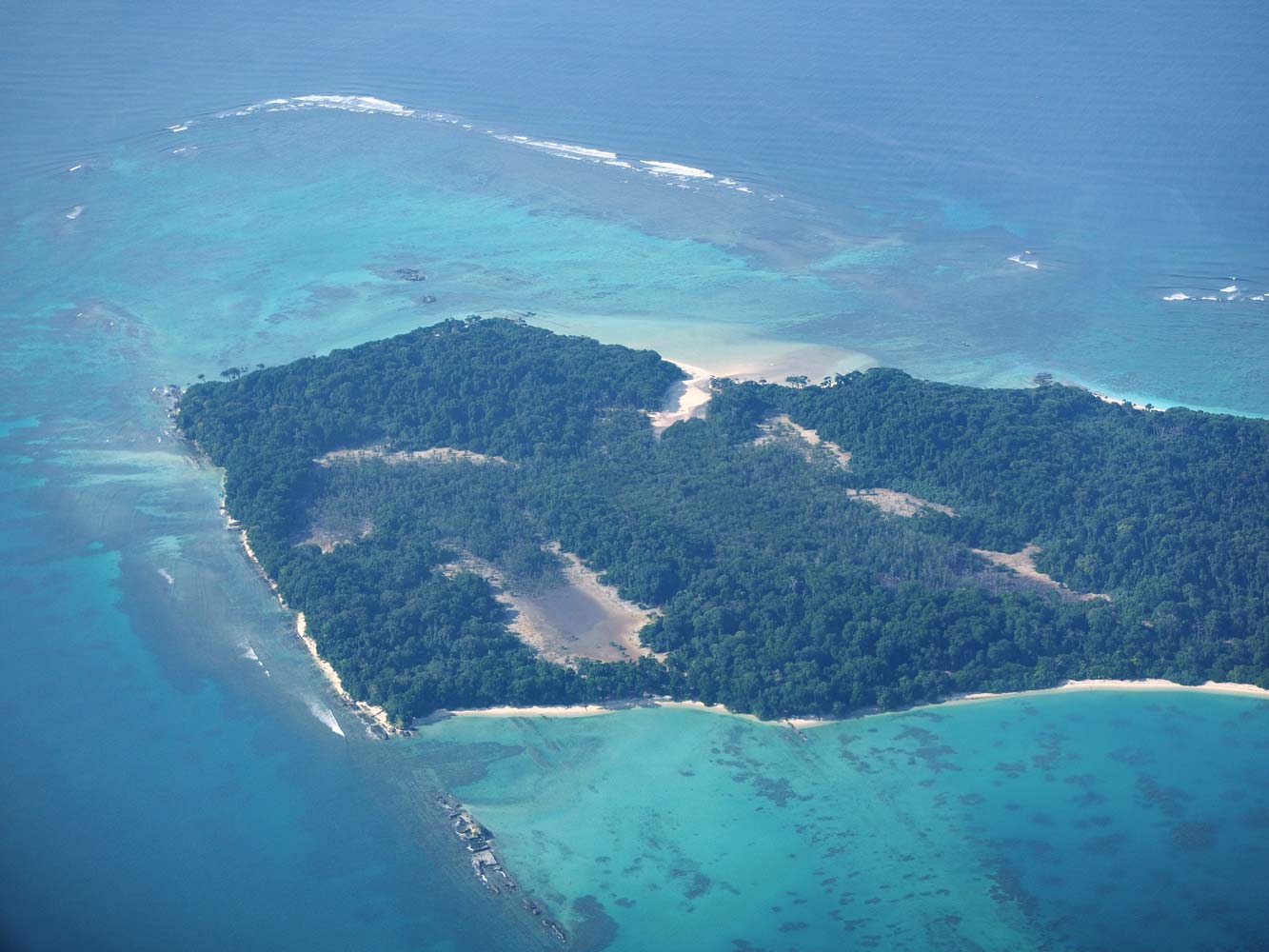
Boat Island is just southwest of South Andaman Island.
30 Nov. Port Blair
The flight on Indigo Airlines 6E-972 had a very inconvenient
departure of 6:15 a.m., which meant getting a taxi to the airport in the wee hours.
There wasn’t any point in going to bed, so I sat down with the computer for writing
and internet surfing. Around 2 a.m. I roused the hotel man to let me out of the
gate—he didn’t really mind as that’s his job—and headed to the main road nearby
in hopes of catching a taxi to the airport. Kolkata is wonderfully quiet in the
middle of the night, at least most of the time, and I wondered if there really would
be taxis rolling by. There were a few and I got a fast ride for 400 rupees. I felt
uncomfortable when the driver zoomed through red lights, but that seems to be the
way it’s done here. The Indigo check-in desk was already open when I arrived at
the airport about three hours ahead of departure. An Indian friend who travels extensively
had recommended Indigo for best on-time service, and I had a good flight with the
airline four years ago from Kolkata to Bangkok. Passenger ships also make the journey
from Kolkata to the Andmans, but I thought the 40-50 hours at sea might go by very,
very slowly.
I had bought the air tickets to and from the Andamans
via MakeMyTrip.com, but a website error failed to state that the ‘Special Fare’
to Port Blair was hand luggage only. I was worried that a huge fee would be assessed
for my backpack, however the friendly check-in fellow asked only 200 rupees and
offered a window seat near the front. Together the two flights cost a bargain 10,444
rupees ($160), but if I had to cancel or change dates the fees would have consumed
most of the purchase price! Kolkata’s airport has a spacious new terminal, uncrowded
at this early hour, but shortage of jetways meant a bus out to the plane. The Airbus
A320 rolled down the runway just as the red sun cleared the horizon. The smooth
flight climbed above India’s murky brown haze and took about two hours. Rows of
tiny clouds hovered over the deep blue sea below. Last winter I had views of the
Andamans while flying from Bangkok to Sri Lanka and on the return, and the islands
looked relatively flat. But on approach to Port Blair I saw rugged jungle-clad hills.
The Andaman and Nicobar islands are not only far closer to Southeast Asia than India,
but they are part of an undersea range that connects Myanmar with Indonesia’s Sumatra
Island. Altogether the archipelago has 556 islands, islets, and rocks. Barren Island,
off to the east has an active volcano, but foreigners cannot visit.
Even though no flights connect Southeast Asia and the Andamans, foreigners arriving
at Port Blair still have to go through immigration to get a Restricted Area Permit
and a passport stamp. Officials were friendly and helped with the paperwork. A long
list of rules listed the places that I would be able to visit and prohibited such
things as photographing tribal people or camping on beaches. I grabbed the backpack
and got an old Ambassador taxi for the 200-rupee ride into town and the Aashiaanaa
Residency Inn. When I first made a reservation with Booking.com only my first night
was available, then rooms became very expensive for subsequent nights. But later
the rates dropped and I reserved two more nights. At the lodge I had a choice of
a room with shared bath (750 rupees) near the potentially noisy reception area or
one with private bath (1200 rupees) upstairs, and went with the latter. Air-conditioning
would have added 500 rupees to the price, but I wouldn’t have used it as the weather
felt pleasantly cool. I got a simple breakfast of an omelet, toast, and tea from
the hotel for 120 rupees, then crashed.

Boat Island is just
southwest of South Andaman Island.
Later I did some writing, then
thought about places to visit in the Andamans. Havelock Island, about 2.5 hours
northeast by ferry, seemed the most appealing destination and is said to have the
best scuba diving. I also thought of taking boats or buses north through the length
of the main Andaman islands to the Diglipur area for jungle hiking and perhaps a
chance to see turtles laying eggs on beaches. The 325 kilometers takes about 12
hours by bus, so stopping off on the way for a detour to Long Island, said to have
good scuba diving, seems a good idea. In the evening I went to the hotel’s rooftop
restaurant for a dinner of tomato soup and mixed vegetable curry. Afterward I updated
the journal text. The air is refreshingly clean here, especially compared
to the dusty atmosphere of the northern Indian plains. Also, vegetation is bright
green instead of dust colored! And it helps that fewer cows and dogs roam the streets.
On the other hand, lots of trash lies strewn about on roadsides and shorelines as
Indians do not take any better care of their environment here than on the mainland.
1 Dec. Port Blair
This pleasant sunny day with some thin clouds felt a bit warmer
and more humid. After a simple breakfast at the hotel, I started off on foot toward
the Andaman and Nicobar Tourism office but soon caught an autorickshaw. Staff at
the tourism office had brochures and information on government guesthouses, but
not first-hand experience nor information on private accommodations or scuba diving.
My hotel manager couldn’t tell me much about the Andamans either. I am relying
mostly on the Lonely Planet India, then confirming things by telephone.
The tourism office wasn’t a wasted trip because across the street lay the Zonal
Anthropological Museum (150 rupees) with photos, crafts, and even huts of the tribal
peoples in the Andaman and Nicobar islands. The tribes include both people with
Negrito and with Mongoloid features whose ancestors somehow made the perilous voyages
to these remote islands. Some of the tribes fiercely resisted European and Indian
visitors, and the Sentinelese still do. Tribes have gone extinct over the past century,
and others face that possibility. Only the Nicobarese, the largest group at about
30,000, have maintained a stable population; most have converted to Christianity
and have partially assimilated with Indian society. The museum’s exhibits include
the Burmese Karen and Indian groups brought in during British colonial times. More
recent settlers include Bengalese who fled here during India’s partition and persecuted
Tamils who left Sri Lanka. A large gift shop is filled with shell crafts and pearl
jewelry, but alas, no postcards.
I walked north and down to the shore
near Marina Park and continued to Aberdeen Jetty where a very pleasant sidewalk
follows the coast around the north side of town with the sound of gently crashing
surf. An autorickshaw took me to Port Blair’s top sight, the Cellular Jail National
Memorial. The 100-rupee ticket states that “The Cellular Jail, the Indian Bastille,
stands as a mute witness to the untold sufferings, valiant defiance and undaunted
spirit of the fire brand revolutionaries against the brutalities of the British
barbarism.” The British began deporting pesky revolutionaries to the Andamans soon
after the 1857 First War of Independence, then built this enormous prison in 1896-1906
with seven wings, each three stories high, that radiate from a central tower. Political
prisoners sentenced here felt their fate as devastating as a death sentence, and
some died from brutal treatment and forced labor. They would spend long periods
in solitary cells—that’s the ‘cellular’ in the jail’s name—with few chances to socialize
with fellow inmates. Hunger strikes over the years gradually forced the British
to improve conditions and eventually return the prisoners to jails in India. Japanese
used the jail during their very harsh World War II occupation of the Andamans. Demolition
of the prison after Indian independence came to a halt when citizens called for
making the site a memorial to the freedom fighters once held here. Two and a half
of the wings, along with the central tower and the front building, survive as a
testament to the dark times. Exhibits with photos and paintings tell of the extreme
hardships that political prisoners endured. A work shed, one of which stood between
each wing, has mannequins in different styles of shackles used for recalcitrant
prisoners and examples of the oil presses that required great effort to make the
daily quotas of coconut and mustard oil. Today’s visitors are free to roam the long
corridors of the jail, step into the bare windowless cells, and climb the tower
and rooftops for views.
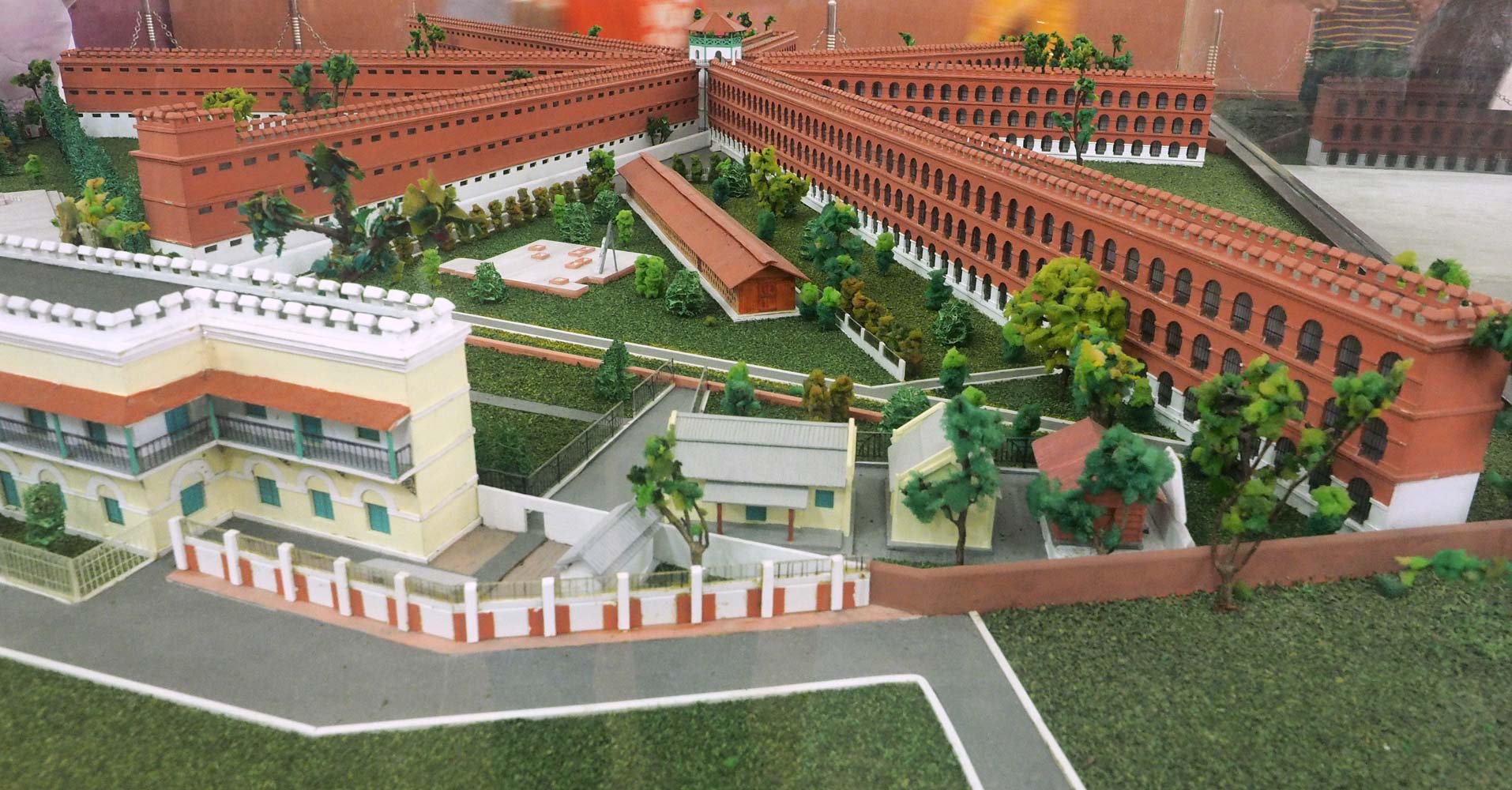
A model shows the
prison as it looked during operation.
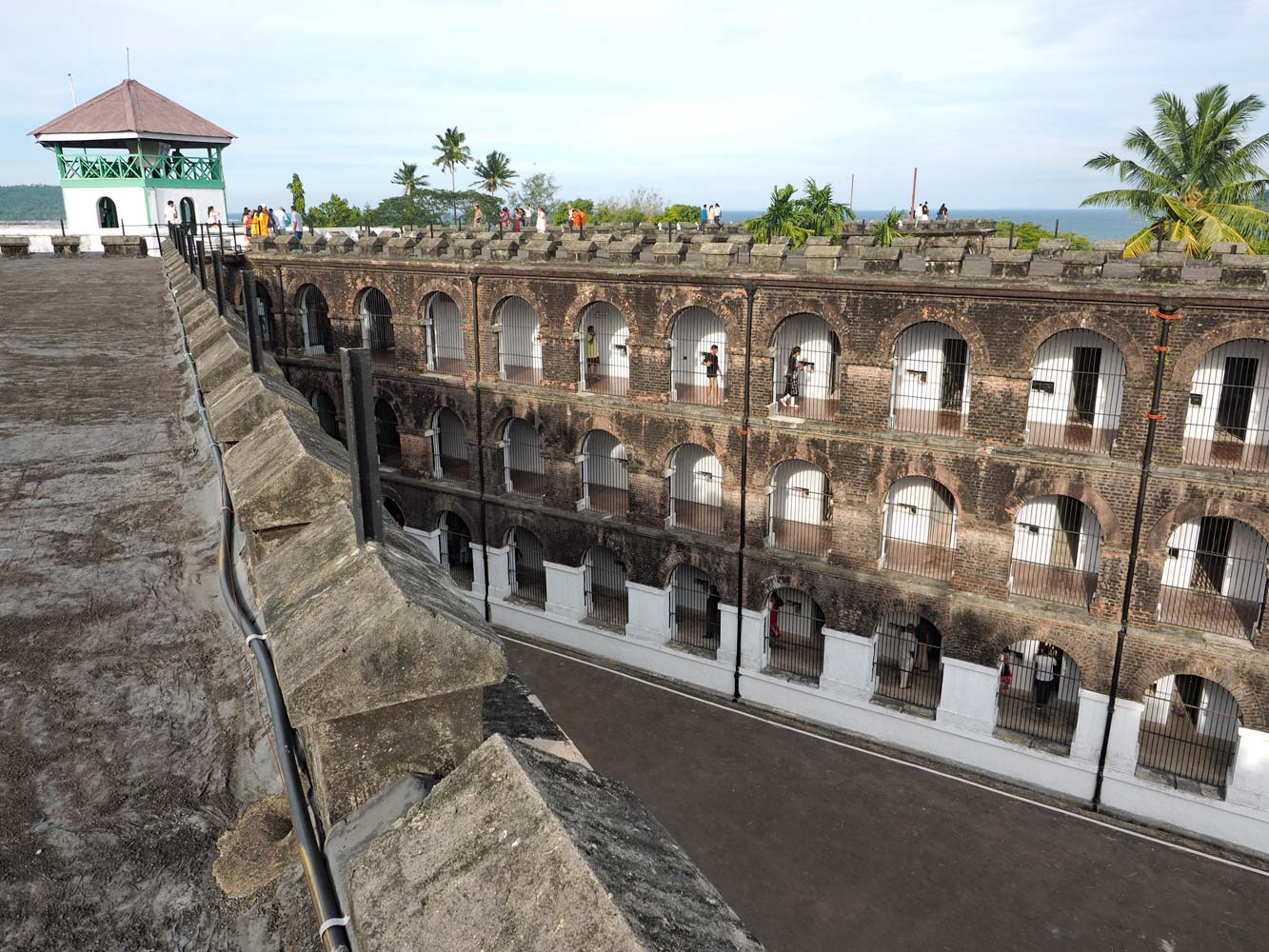
The wings converge
on the central tower.
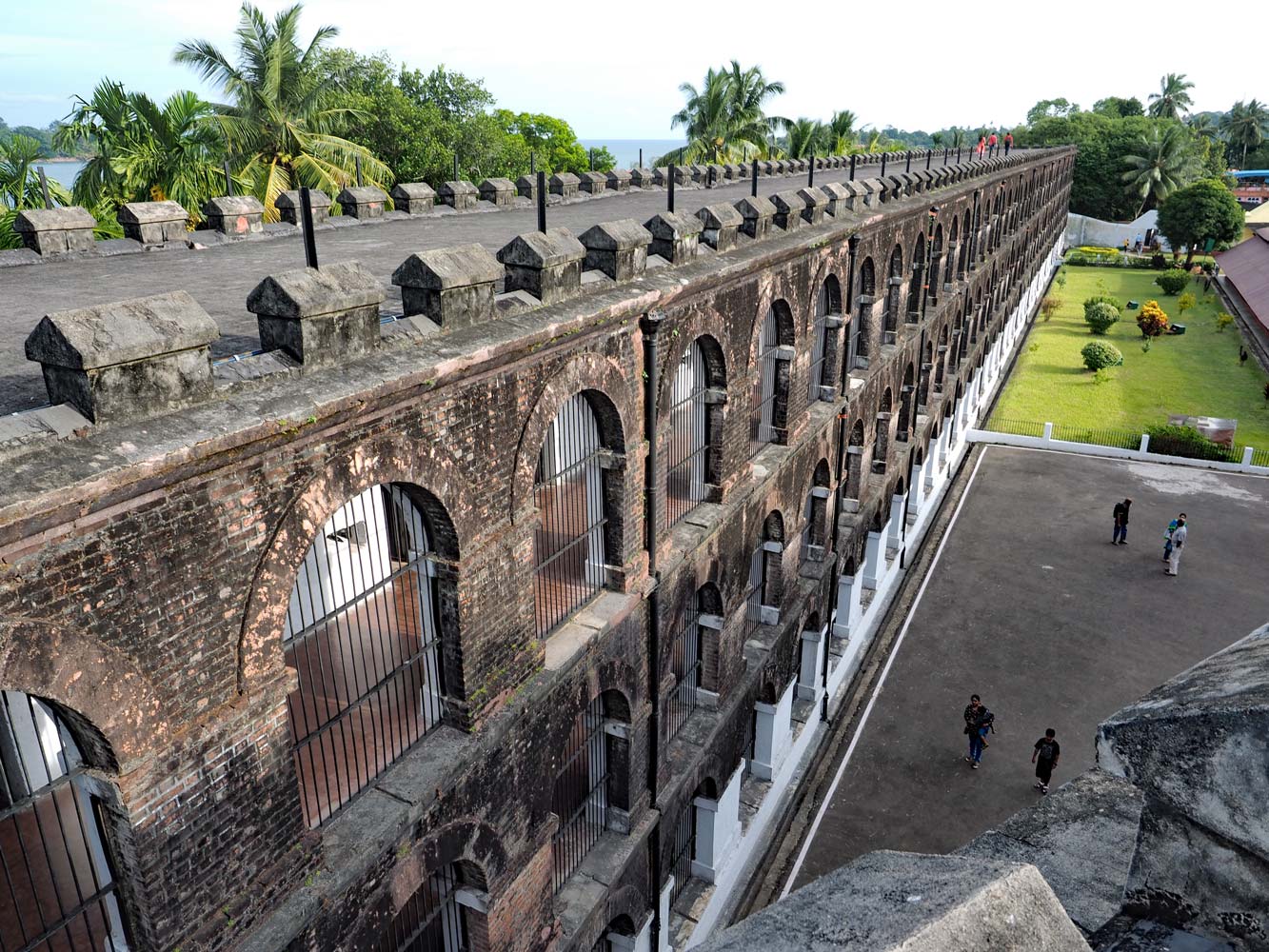
Rooftops offer
views of Port Blair and the sea.
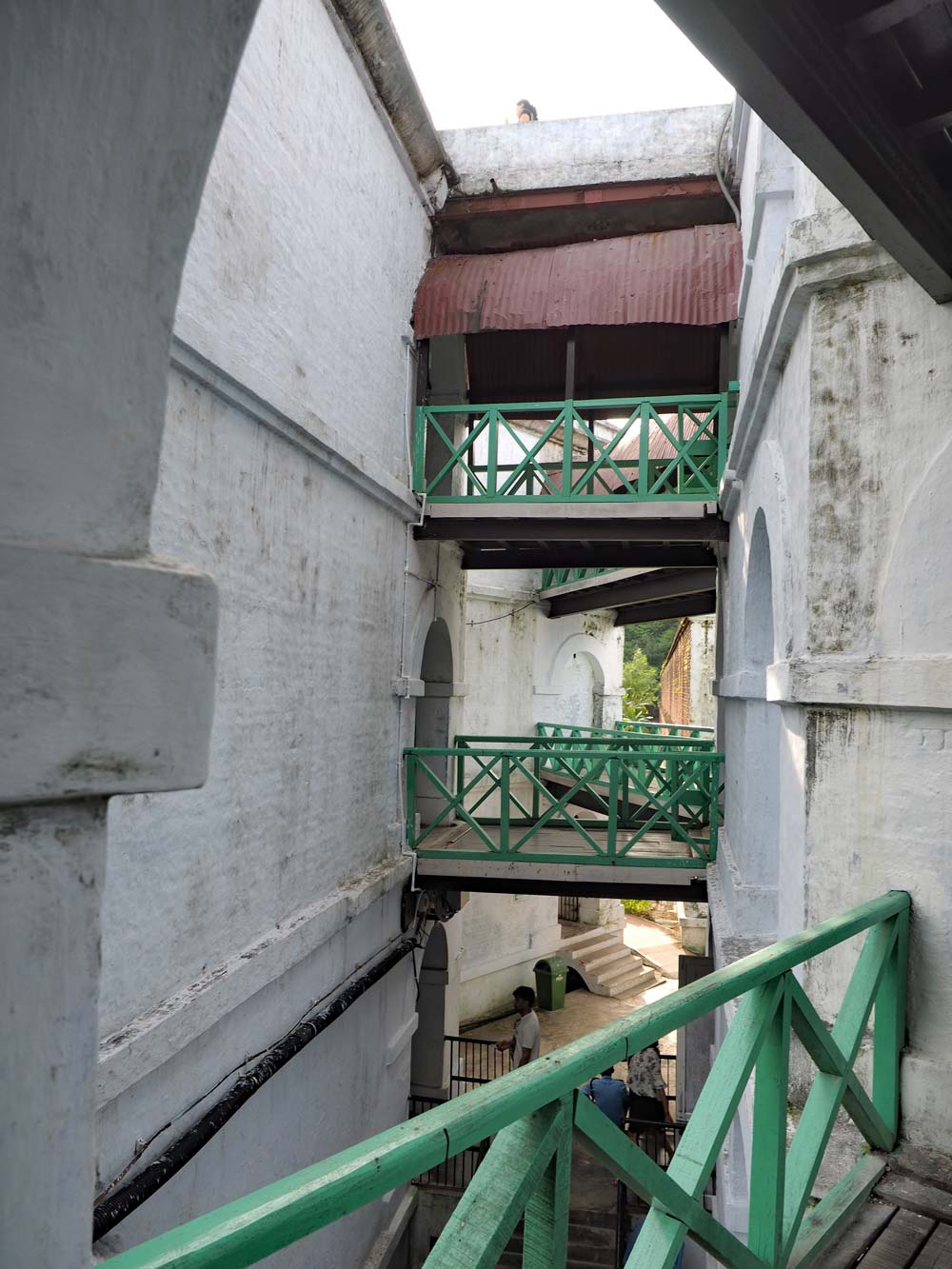
These bridges
connect the wings with the central tower.
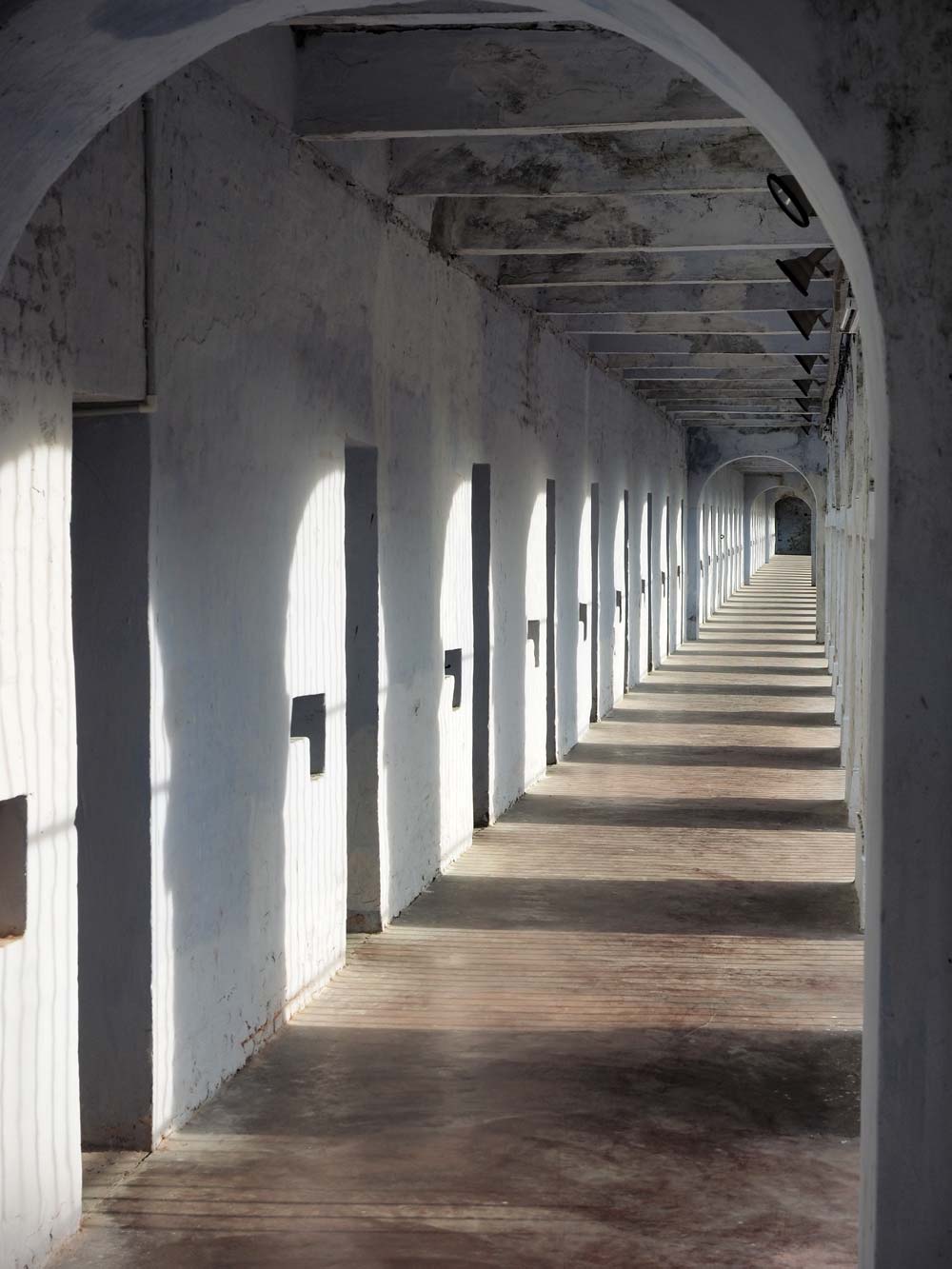
Long lonely
corridors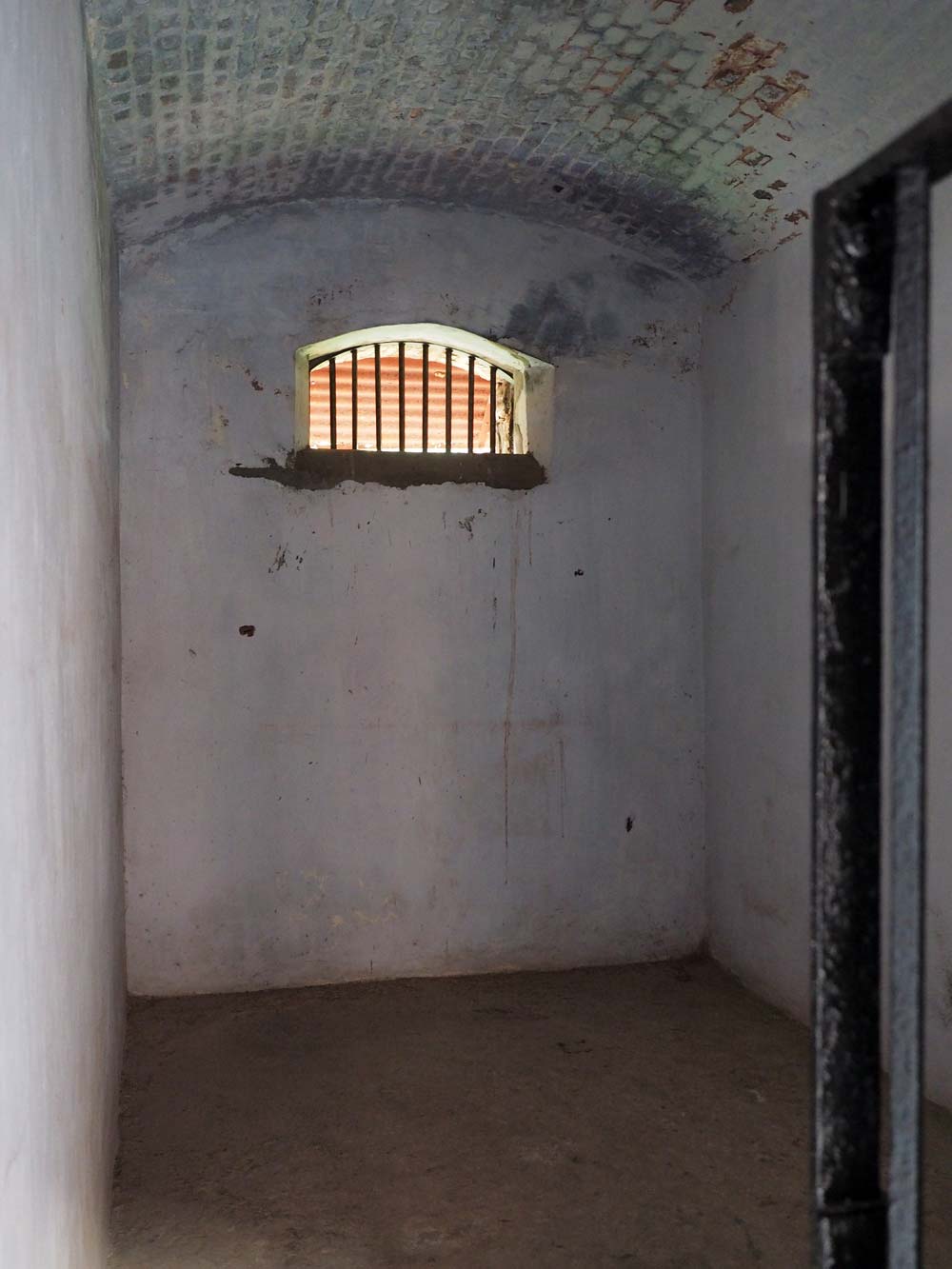
And cramped barren cells.
I swung by the nearby aquarium, very basic with small tanks of small fish and exhibits of ghostly coral skeletons and bottles of pickled fish. A short autorickshaw ride brought me to the hilltop Hotel Lalaji Bay View, where I had a palak paneer dinner in the rooftop Excel Restaurant as the final sunset glow departed from the sky. The sun is early to bed, early to rise here in the Andamans!
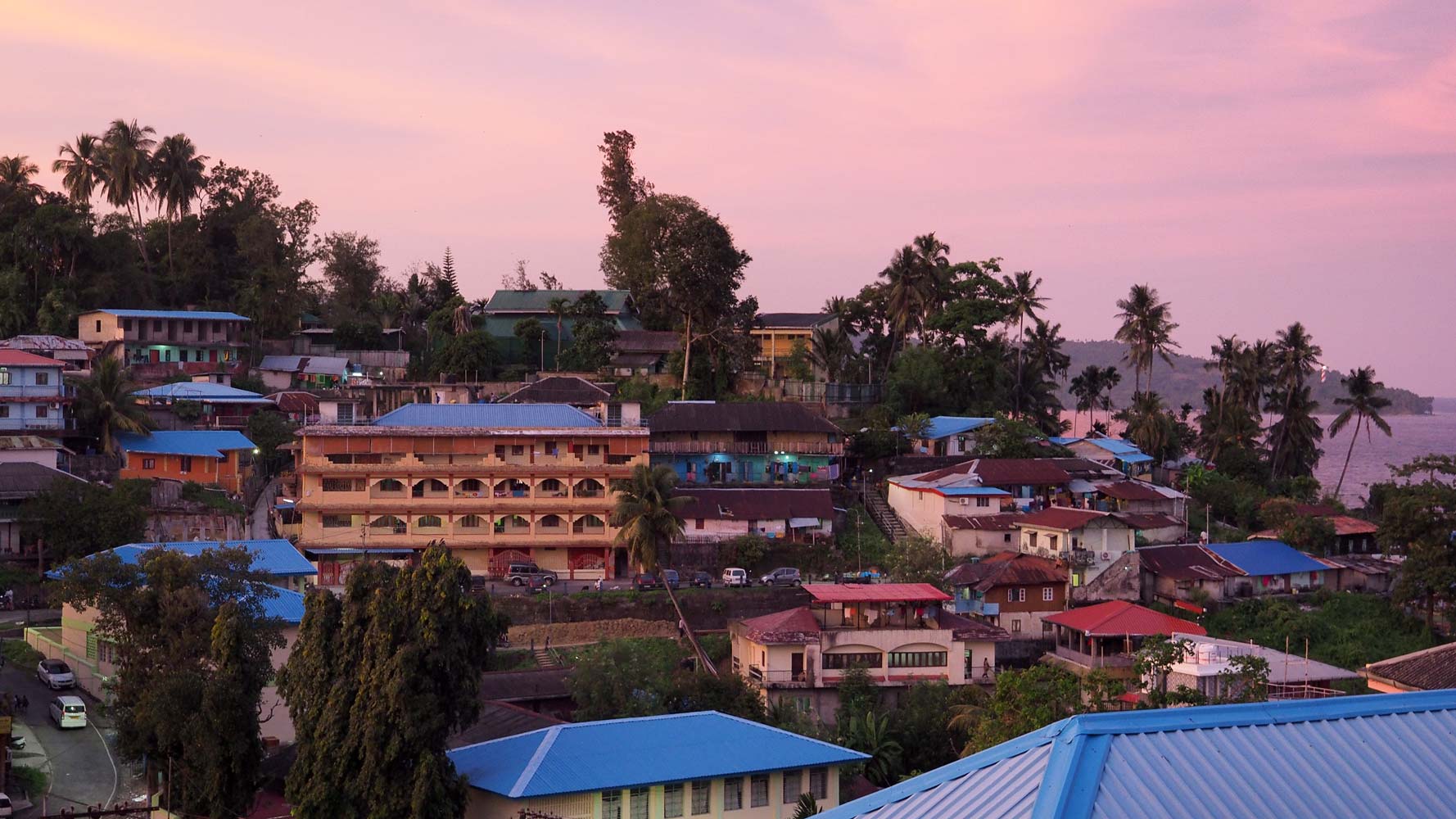
Sunset colors from
the Excel Restaurant
2 Dec. Port Blair
Today felt full on tropical—sunny
and hotter with scattered cumulus clouds. After breakfast I headed over to Aberdeen
Jetty for the short hop by boat to Ross Island. Lots of people waited for their
boat here, but I couldn’t find the ticket office. Then an Indian fellow invited
me to come with his group of New Zealand visitors and their hosts. We donned bulky
life jackets and boarded a small covered boat for the 800-meter crossing, taking
20-minutes and catching some spray as we bounced through the waves. I think all
the tours allow just two hours on the island, though I would have liked to stay
longer.
Political prisoners arrived in 1858 on two ships and began
the task of clearing jungle for a new settlement, which became the British headquarters
for the Andaman and Nicobar islands. The remote town offered all the comforts of
home with three clubs, a swimming pool, tennis courts, a ‘superb’ bakery, library,
shops, and churches for its population of about 500. The good life got a jolt from
an earthquake in 1941, then nearly all the British fled by the following year when
the Japanese invaded. The settlement remained abandoned after World War II and now stands
in picturesque ruin. Ficus trees have wrapped around some of the old structures. Ross Island took the brunt
of the 2004 tsunami, saving Port Blair from major destruction, though other parts
of the Andaman and Nicobar islands suffered greatly.
I walked beside
the rusting boilers of the water distillation plant and the nearby bakery, then
climbed past the Subordinates’ Club that once sported Italian stained-glass windows
and a teak dance floor supported by springs. Atop the ridge rises the shell of a
Presbyterian church, and farther south a graveyard with sad tales to tell. In the
other direction I came to an Anglican church, in relatively good shape, and a line
of ruined barracks beyond. Also on the ridge sits the formerly grand Commissioner’s
Bungalow that had a ballroom and Italian tiled floors, but only overgrown brick
walls remain today. Back near the boat dock I met up again with the New Zealanders,
and we waited for our little boat. The ride back was much smoother without any sea
spray.
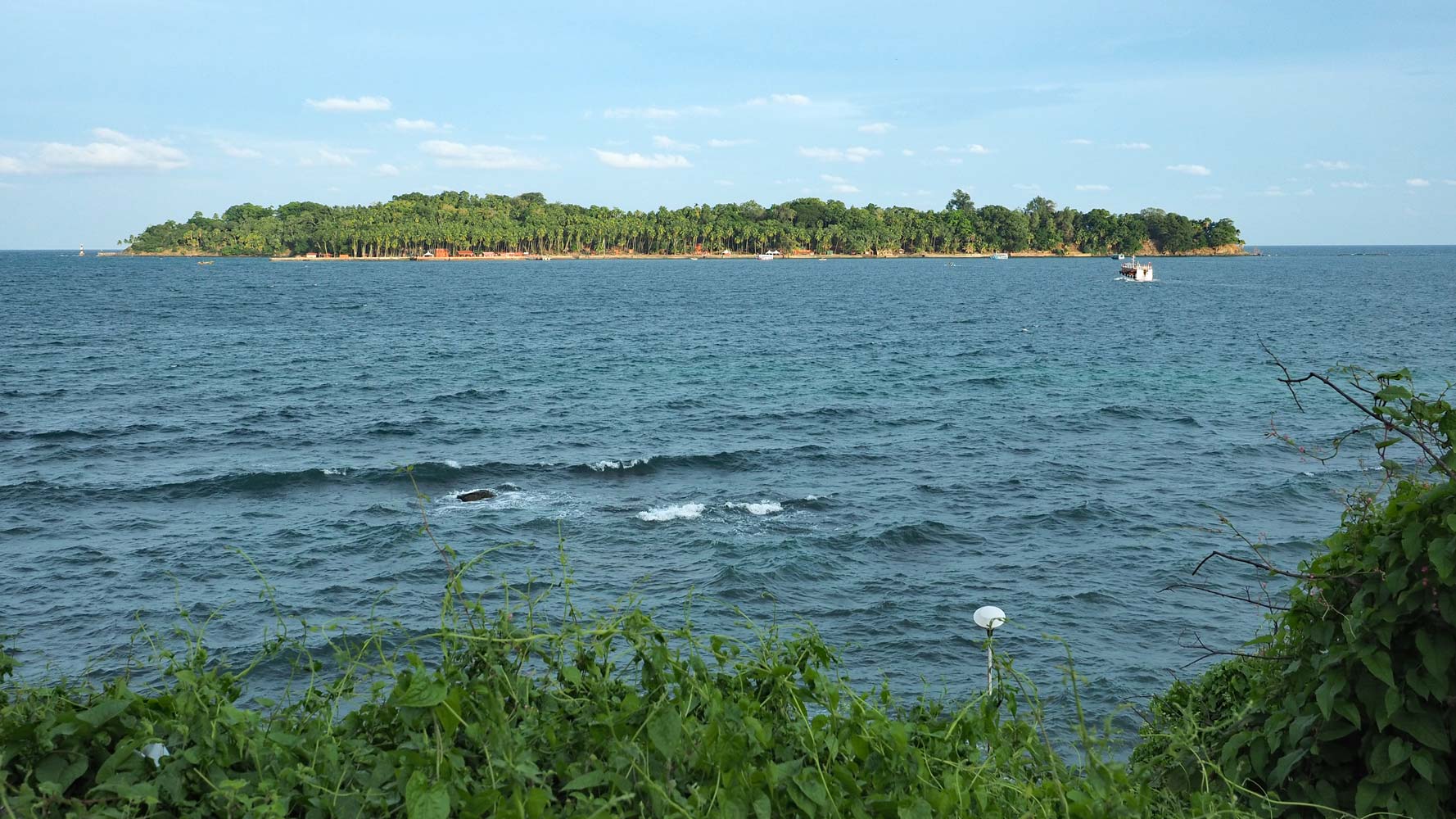
Small ferries
shuttle visitors out to Ross Island.
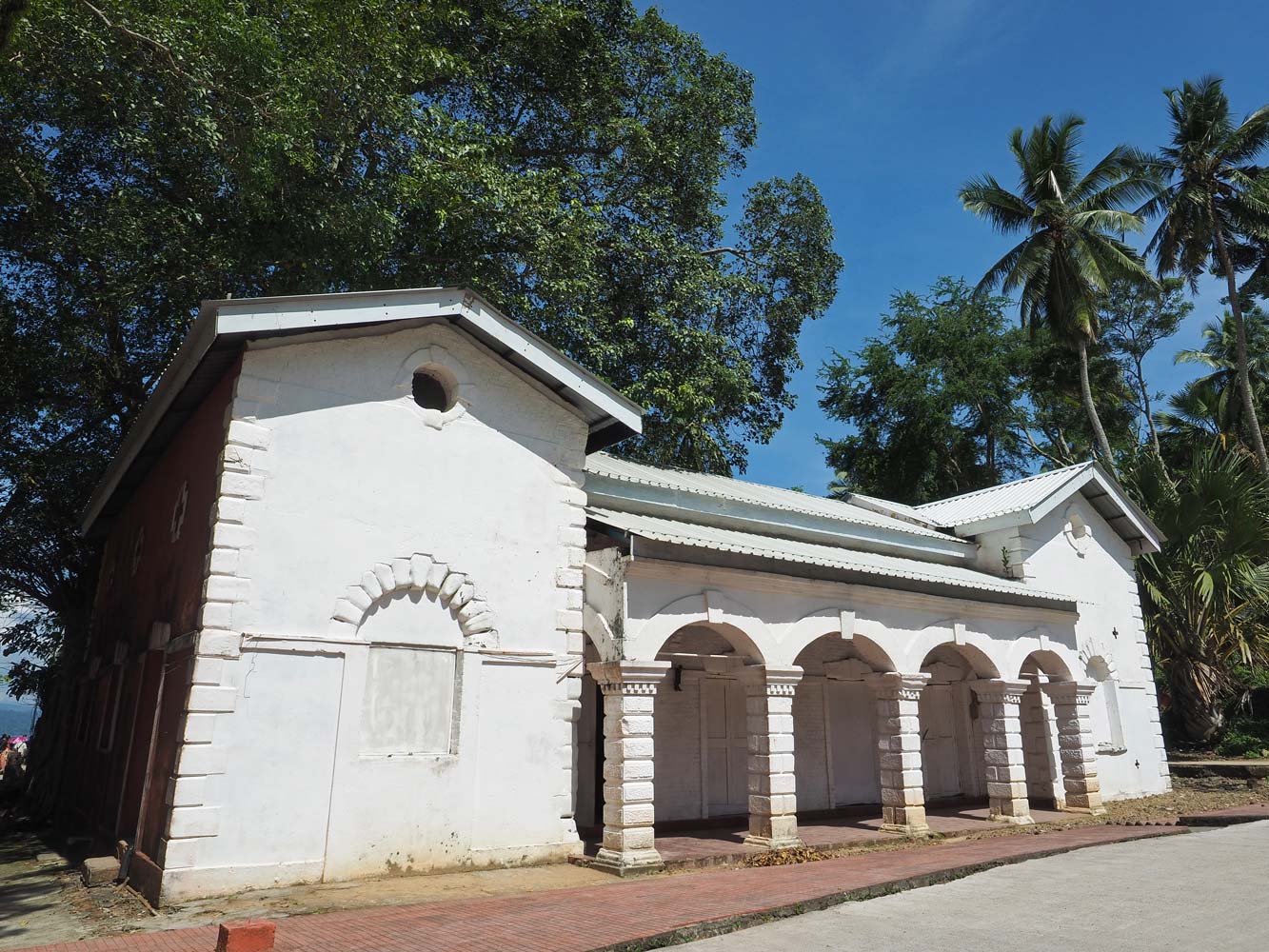
The bakery still
stands, but the bakers have long since departed.
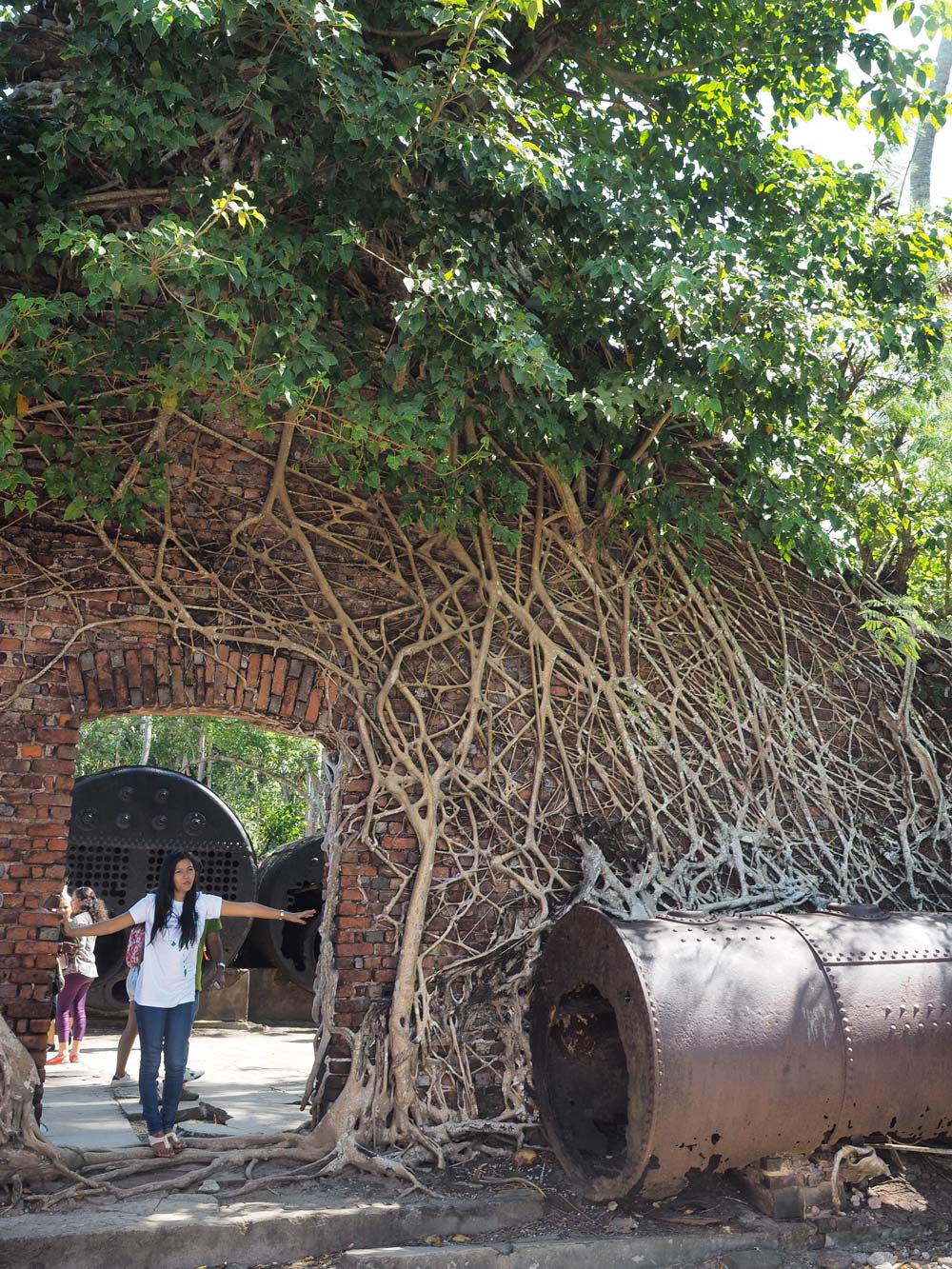
Giant boilers rest
among ruins of the Water Distilling Plant
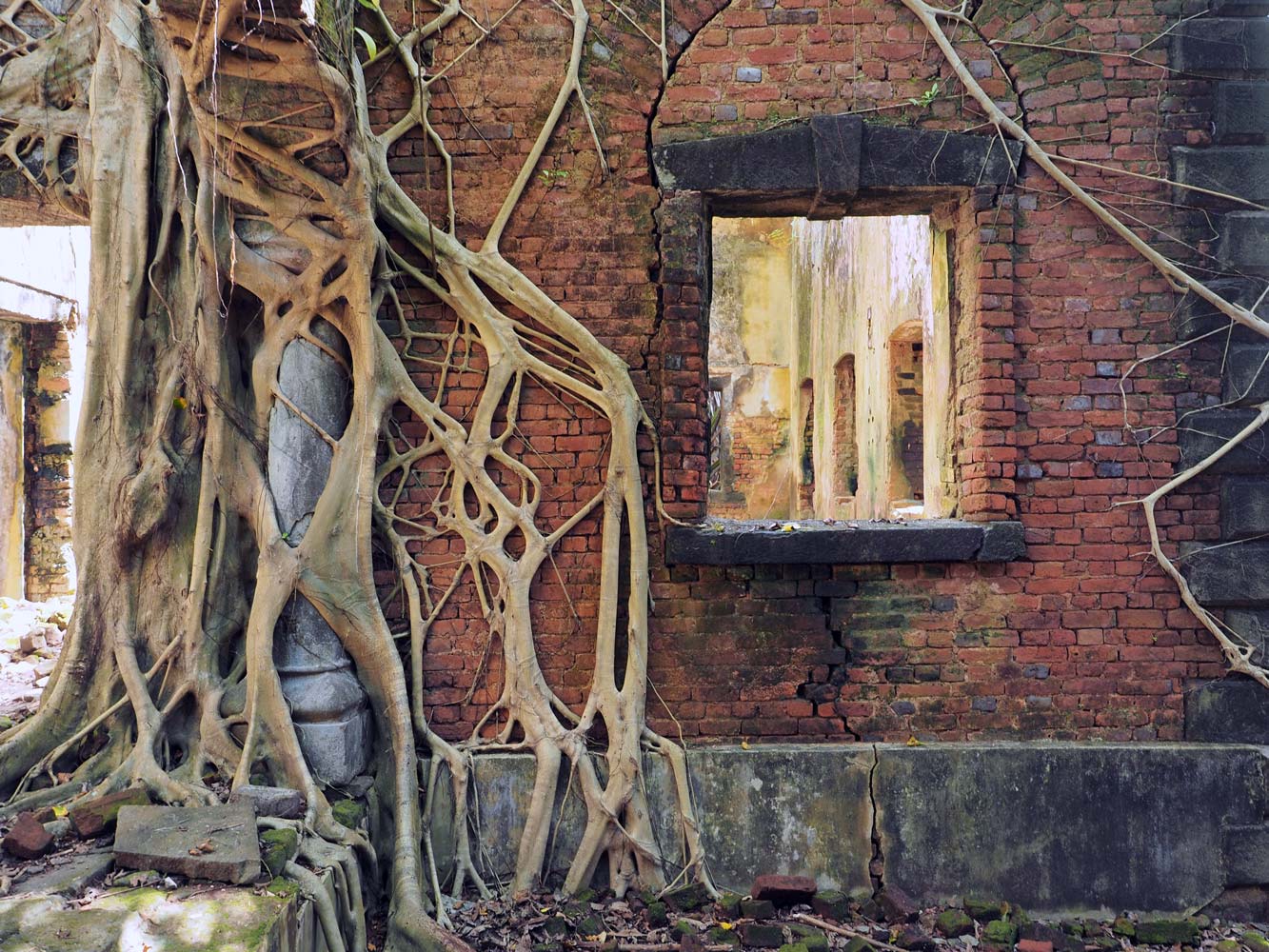
Only ghosts hang
out in the Subordinates’ Club.
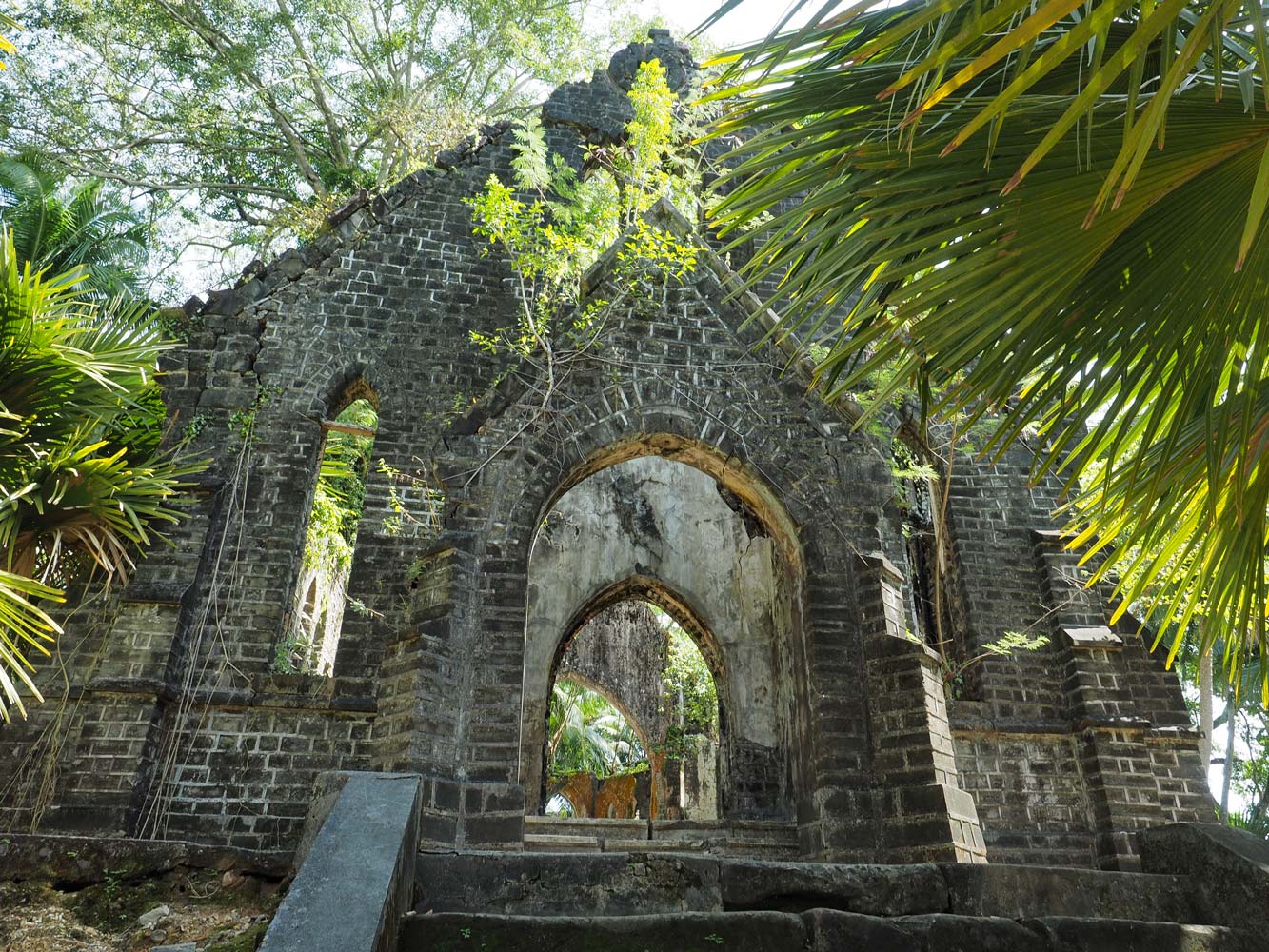
The Presbyterian
church still soars from its ridge-top setting.
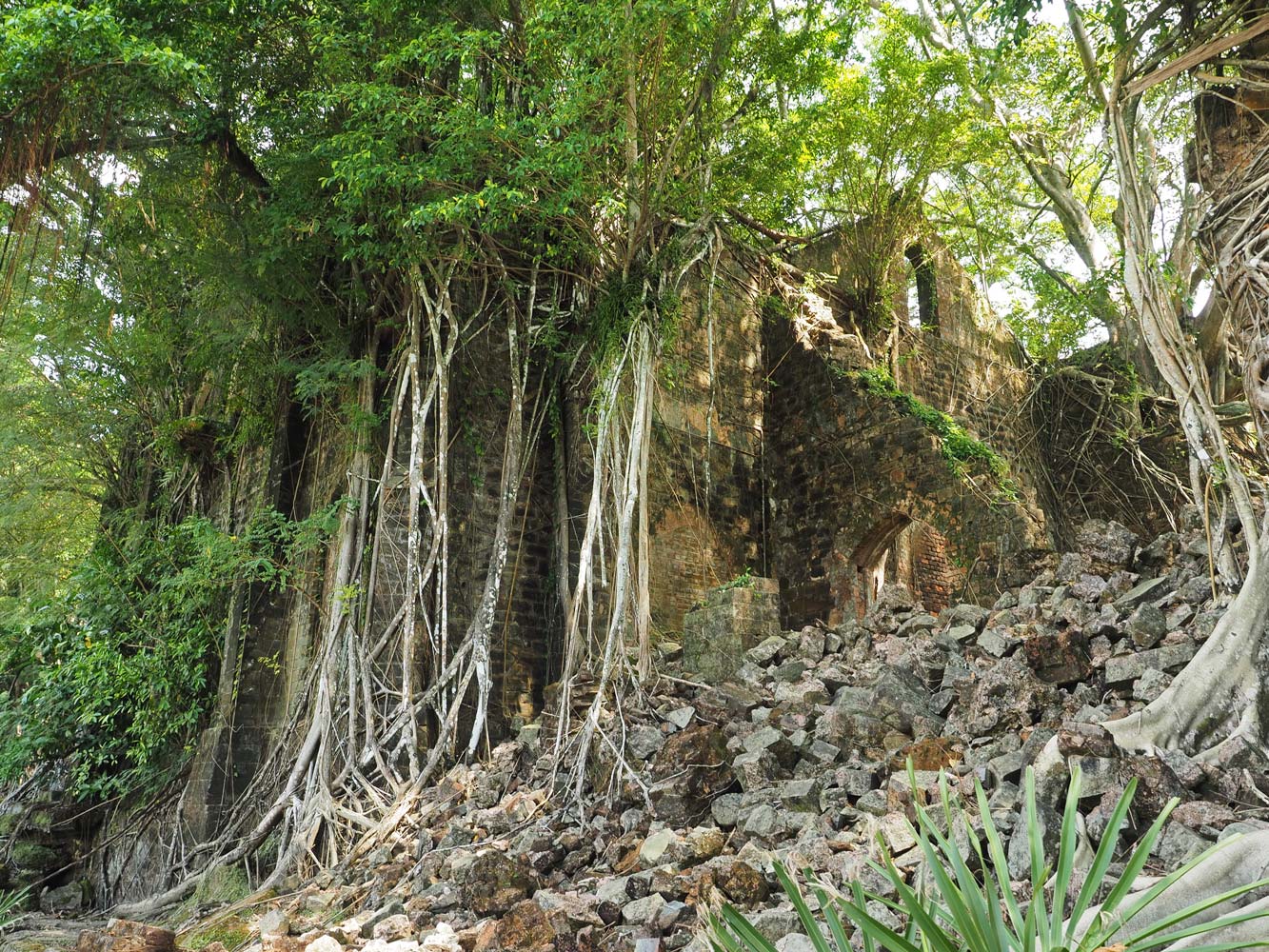
These barracks
slowly crumble atop the northwest end of Ross Island; other barracks here are
still in good shape.
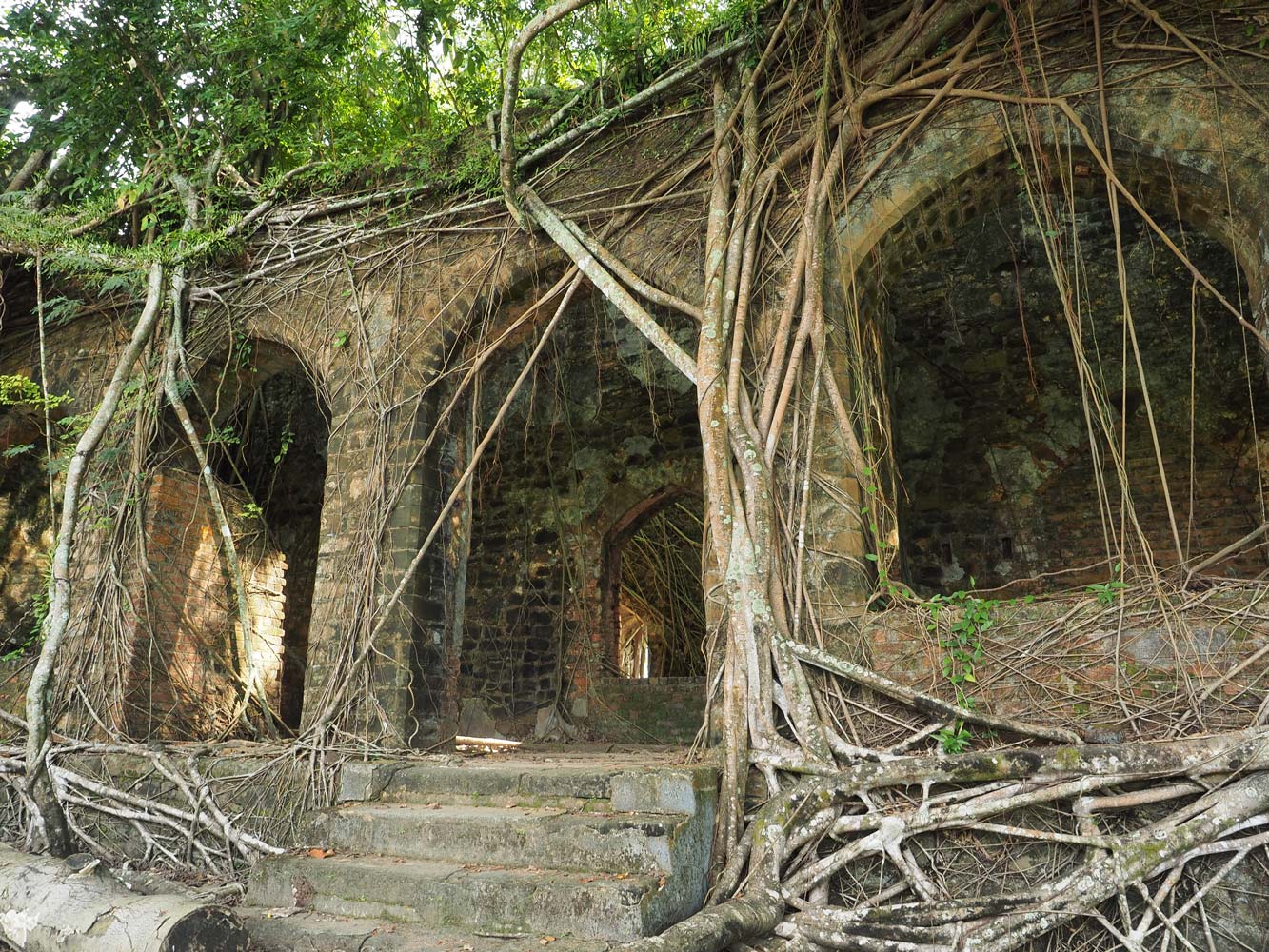
Nature takes over
in the ruined barracks.
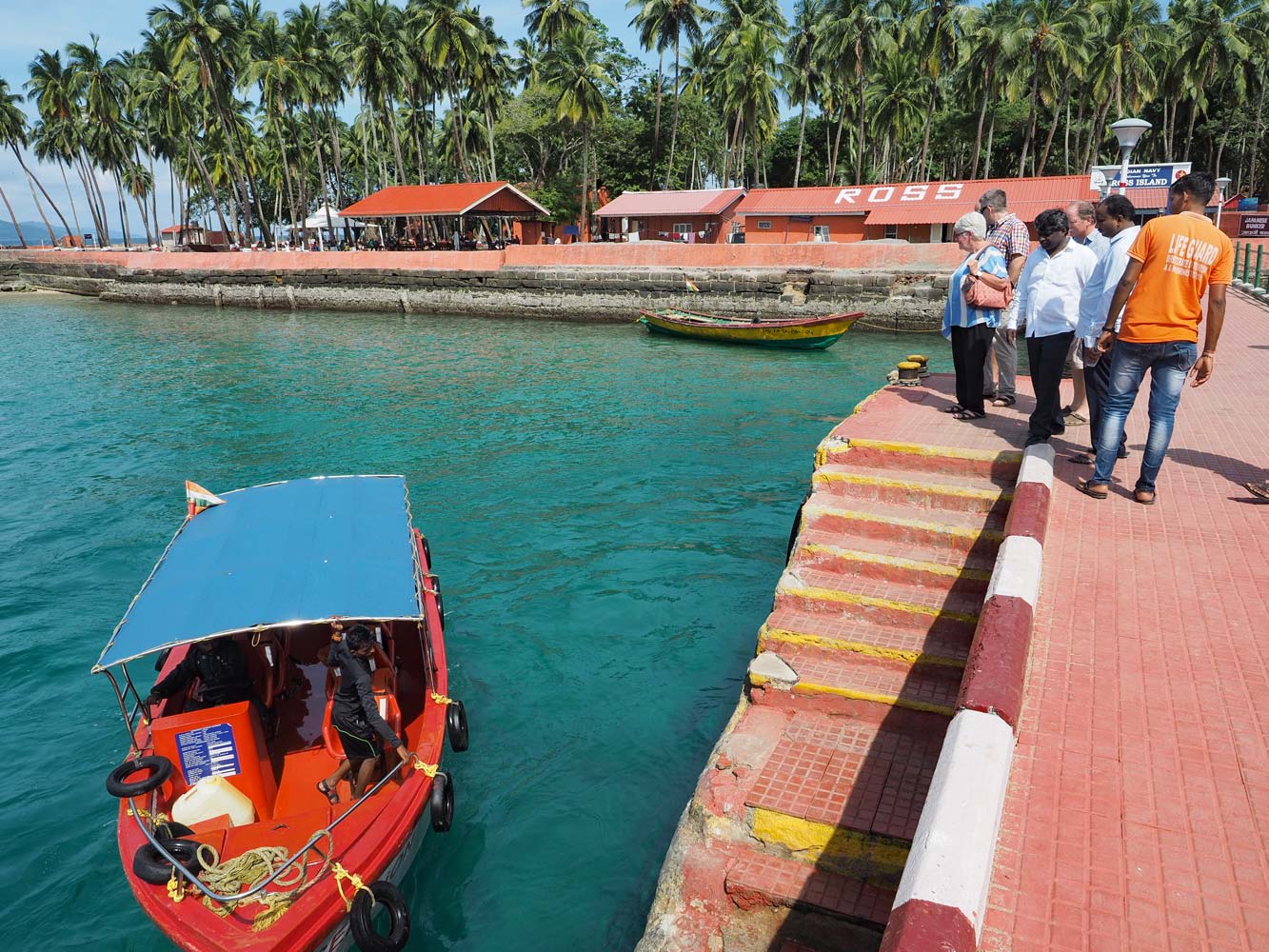
This little boat
will take us back to Port Blair.
After a paneer pakora snack, I walked south through Marina Park
with its statues and greenery, then followed a sidewalk beside the rocky shore to
the southeast with fine views of Ross Island. At its end I found a ride in an autorickshaw
back to my hotel. I decided to head tomorrow to Havelock Island, but the government
ticket office was said to be closed today for a Muslim holiday. Rather than go to
the dock and fight crowds tomorrow, I let the hotel manager book a seat on a more
expensive private ferry online, but that failed when the payment didn’t go through.
Then he arranged for an autorickshaw driver to buy my ticket, and the best available
was an 1150-rupee ticket (plus 100 rupees for the driver) scheduled to leave tomorrow
morning at 6:45 a.m. on the Green Ocean 1. For dinner I had a malai kofta at La
Marina around the corner, though most of the Indian crowd here went for the simple
buffet.
Internet connections in the Andamans tend to be slow and expensive,
which is inexcusable considering that India not only has satellites, but its own
space program. My hotel offered wi-fi in the lobby only at a cost of 60 rupees/hour,
but I never bothered to connect. The phone’s internet had worked well on mainland
India, but here it’s hopeless. On the other hand part of the appeal of the Andaman
Islands is to disconnect from the world! With so much sad news coming from so many
places, that’s not a bad idea.
3 Dec. Beach 5, Havelock Island
The
day started off pleasantly cool, then became increasingly hot and humid under partly
cloudy skies. As is common in the Andamans, the Aashiaanaa Residency Inn has an
ungenerous check-out time of 8 a.m., so the early departure time for Havelock Island
was timely. From the Inn I had an easy walk of a few hundred meters to Phoenix Bay
Jetty, where I had to wait for the check-in process—and pay an extra 50 rupees—before
boarding. A government boat was also leaving about the same time and had attracted
a huge crowd, so I doubt a ticket on it would have been available. Onboard I had
a comfy upholstered seat in an air-conditioned cabin, though myself and most passengers
also stepped outside to watch jungle-clad islands glide past during the 2.5-hour
gentle journey. Inside a Bollywood ‘masala’ movie played with the mix of humor,
violence, justice, and music that so appeals to Indians. I was the only Westerner
aboard, and I saw justa handful of them among the crowds on arrival at Havelock’s
jetty on the north end of the island. A tourist office near the jetty had very little
information.
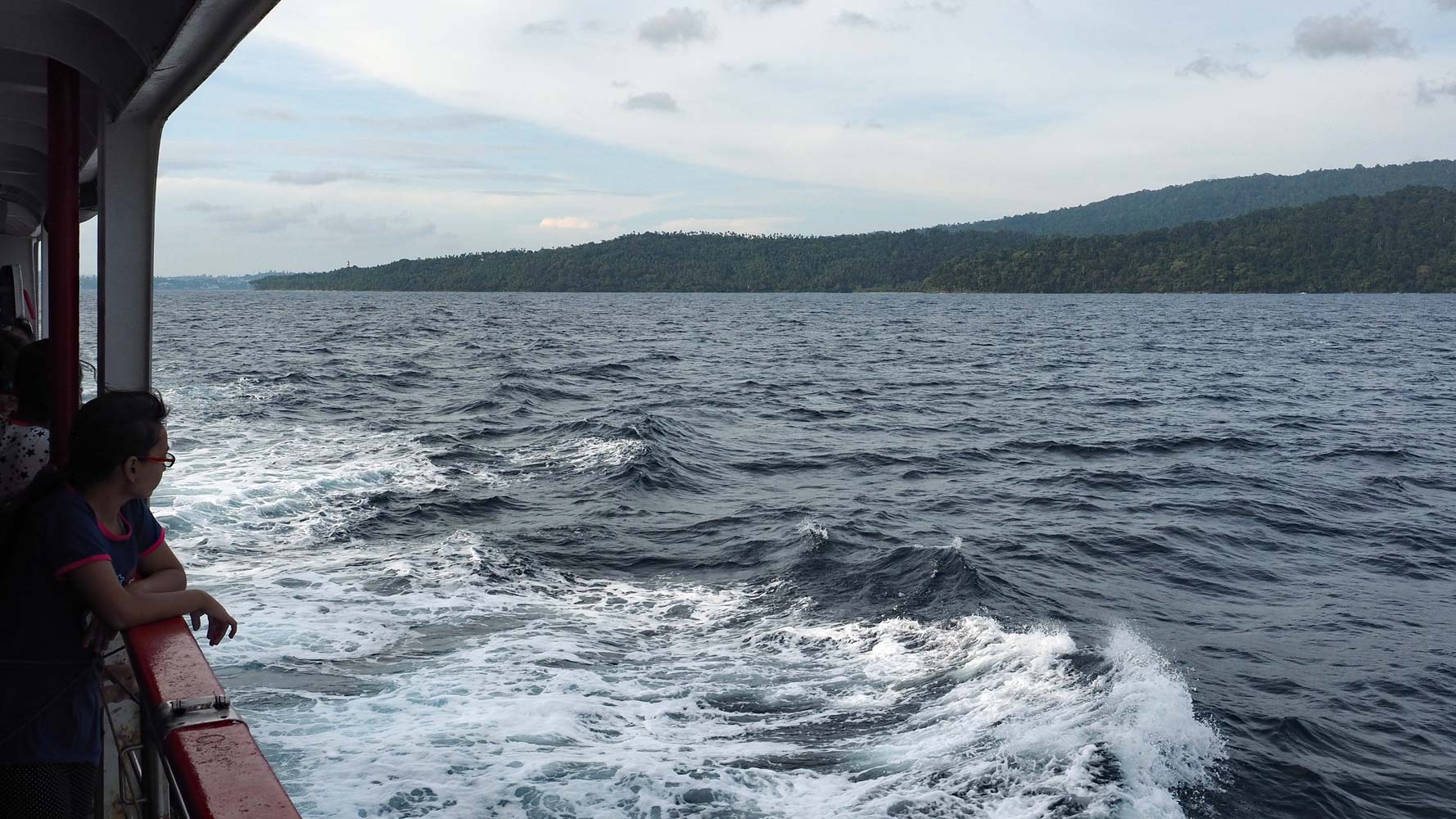
Watching the
islands go by on the journey to Havelock Island
With no reservation, I just hopped in an autorickshaw
for the 100-rupee ride south to Beach 5, where many accommodations line the road.
Orient Legend Resort, mentioned in the Lonely Planet guidebook, seemed a likely
place to stay, and had a choice of very basic mattress-on-floor bamboo huts (400
rupees) or basic rooms with attached bath (1500 rupees), which seemed a better bet.
I wasn’t sure this was the best deal, so I walked north and had a look at a bunch
of other resorts. Most turned out to be full and the rest more expensive, so I returned
to Orient Legend Resort and checked in, then had breakfast in its little restaurant.
The resort, surrounded by coconut and betel palms, sits beside a sandy beach where
the shallow sea glows a bright turquoise color for a long ways out before turning
to dark blue. Most restaurants specialize in seafood, but this morning I noticed
a pair of vegetarian places to the north on opposite sides of the road. So in the
evening—it gets dark at 5 p.m.—I walked north to Shakahaar and had a chatpata paneer
(cheese cubes in a fiery and tasty tomato sauce). A hazy full moon rose above the
coconut palms.
Several scuba dive shops line the road near my resort,
and I stopped at Andaman Bubbles for information. Strong winds had caused cancellations
of boat trips, but I could check back in a few days to find out if conditions had
improved. Diving costs in the Andamans run about $75-100 for a pair of dives, about
twice that of Southeast Asia. Part of this is an 18% government tax, but it still
seems too high. Nevertheless I do plan to go diving here to see the undersea life.
4 Dec. Beach 5, Havelock Island
On another fine and breezy tropical day, I tried
my luck with wi-fi at a nearby resort—there’s none at all where I’m staying—and
got a feeble connection for half an hour at a cost of 50 rupees. Without internet,
the days seem to have more hours in them, and I’ve had time for reading, thinking
about future travels, and listening to music! I had a spinach and mushroom lasagna
next door at Rony’s, one of the multi-cuisine restaurants that are very common on
the island.
5 Dec. Beach 5, Havelock Island
Wind-driven rains hit
the island many times during the day and into the night, sometimes with torrential
fury. I stayed indoors and worked on sorting photos from the recent European bicycle
ride, something I didn’t have enough time then. Staff got hold of a table for me
to put in the room, so that I would have a place to sit and write. Although the
resort tends to be quiet and peaceful, every now and then a coconut or betel nut
crashes onto a metal roof with a terrific bang. Electric power, seemingly unreliable
in the best of times, went off a lot today. For dinner I headed over to Rony’s for
a simple, yet filling vegetarian thali.
6 Dec. Beach 5, Havelock Island
Rain continued to fall all day, though occasionally tapering off to a drizzle, when
I went out to stretch my legs. The sea, so pretty a few days ago, now had a dull
brownish-turquoise color and the dark blue farther out had disappeared entirely.
As usual I had a tomato omelet, milk porridge, and milk tea at the resort while
all the Indians went with poori and vegetables. The little restaurant is non-smoking,
something I’ve come to appreciate as many of those in the neighborhood get stunk
up with smoking Europeans and Israelis. In the evening I braved the wet and walked
north to Anju Coco Resto, a large and slightly upscale restaurant with a long multi-cuisine
menu. Also it’s non-smoking! I enjoyed a South Indian Platter of the classic snacks
of that region—masala dosa, uttapam, idly, and vada—followed by a masala tea.
7 Dec. Beach 5, Havelock Island
Rains stopped soon after breakfast, then bits
of sun came out of uncertain skies. I used the free and very slow internet at nearby
Andaman Divers/Fat Martin’s Café to update my website, check some e-mail, and read
the news, but I couldn’t post photos to Facebook. In the afternoon I walked north
2 kilometers to Govind Nagar, a village with a market, supermarket, and a bank,
but I had to continue north another 300 meters to a pair of banks with ATMs that
accepted foreign cards, but I was out of luck as none of the ATMs were functioning.
My hotel accepts only cash and if the ATMs don’t resume operation I will have to
cut short my time on Havelock. Scuba diving companies are hoping that calm seas
will return after getting stirred up by strong winds of recent days. On the walk
back I stopped at Anju Coco Resto for a flavorful North Indian thali.
8 Dec. Beach 5, Havelock Island
Weather conditions seem to be on the mend. I
hung out and thought about future travels while reading guidebooks. Since I’m now
set up for backpacking, I think I will do non-cycling travels for the rest of my
time in Asia. I’ve already booked a flight to Thailand for the night of January
8th where I will have about 10 days in Bangkok, followed by a 10-day meditation
retreat in the northern Thai city of Chiang Mai, then 10 days to experience Chiang
Mai. On February 6th I have a flight direct from Chiang Mai to Kuala Lumpur in Malaysia.
There I would like to take in city sights, then journey northeast to the jungle
of Taman Negara, Malaysia’s biggest national park. Then on to more jungles in the
vast island of Borneo! Back in the early 1980s I had fantastic adventures in Malaysia’s
state of Sabah in the northeast corner and in eastern Kalimantan on the Indonesian
side. This time I hope to head for the sultanate of Brunei, the only country in
Southeast Asia I’ve not been to. Then I could head southwest along the coast of
Malaysia’s Sarawak state for jungle visits and giant caves. Lastly I could fly to
the multi-cultural old town of Penang on Malaysia’s mainland before continuing north
to Thailand and scuba diving. Meanwhile, back on Havelock Island, I returned to
Anju Coco Resto for another South Indian Platter.
9 Dec. Beach 5, Havelock
Island
35km cycling
On this sunny and calm day I rented a bicycle from a nearby
shop for 100 rupees and headed north. The main thing that Indians look for in a
bicycle is that it’s cheap. This one was styled as a mountain bike, but lacked gears,
suspension, or other frills. The frame was too small, the gearing too high, and
I couldn’t raise the seat enough. I missed my bicycle “Bessie Too,” but bringing
it along on this trip would have been too much work for too little riding. Today
the Axis bank ATM was working, though this bank has a 150-rupee withdrawal fee.
The adjacent State Bank of India would have had fee-free withdrawals, but its ATMs
didn’t work today, or perhaps any day it seemed. A little farther north I came to
the pier, where I checked ferry schedules. I’m thinking of taking a ferry about
two hours north to Long Island, where scuba diving is possible.
Back
at the tiny traffic circle in Govind Nagar, I turned my fat wheels 9 kilometers
southwest across Havelock Island to Radhanagar Beach. Although Havelock Island has
a range of hills running through it, the coastal road had been nearly level. Yet
when I rode inland the hills, which would have been easy on a geared properly fitted
bicycle, were too much and I had to walk all but the gentlest. The warm humid tropical
air felt fresh, though I soon became soaked in sweat. Lush vegetation along the
way glowed in deep hues of green. Radhanagar Beach, famous throughout India, is
the prettiest on the island. Although I’m not a “beach person,” I enjoyed strolling
the long white crescent of sand. Across the sea the length of South Andaman Island
stretched out across the distant horizon. The few small groups of Western women
lying on the beach in their bikinis contrasted with the fully clothed Indian women
who waded into the very gentle surf. Only the bravest people went swimming. Lots
of tiny sand-colored crabs raced across the beach as I passed. Farther along at
a rocky section I saw many hermit crabs, also tiny, but lumbering in their borrowed
shells. Beyond the rocky place I came to a pretty crescent of sand. None of the
beach goers had come this far, and I saw only a trio of locals walk past with a
fishing net. With the tide near its high mark and mangroves blocking the way beyond
the cove, I returned to the road, taking a jungle trail that parallels the beach
for the first part of the way.
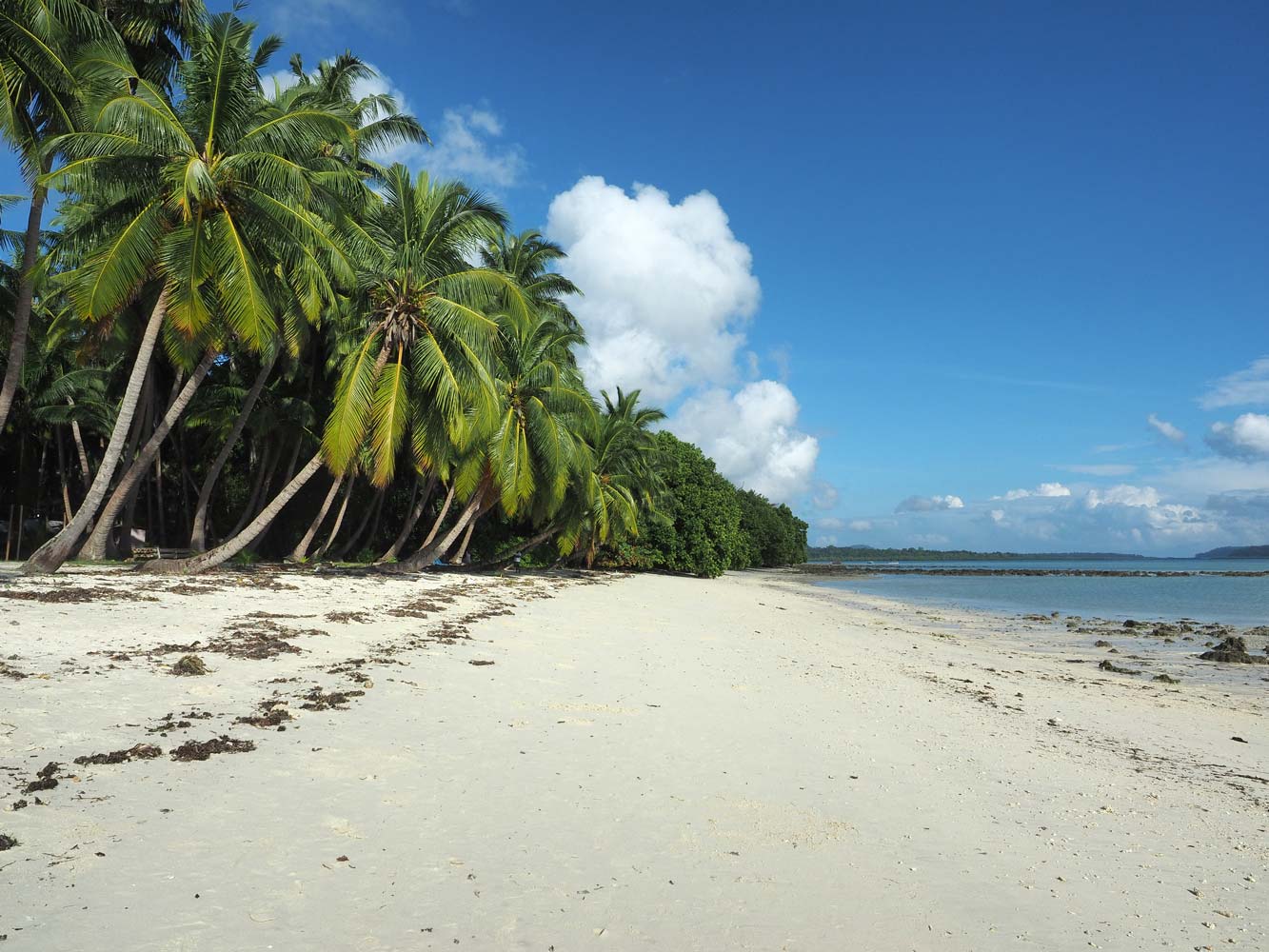
Radhanagar Beach
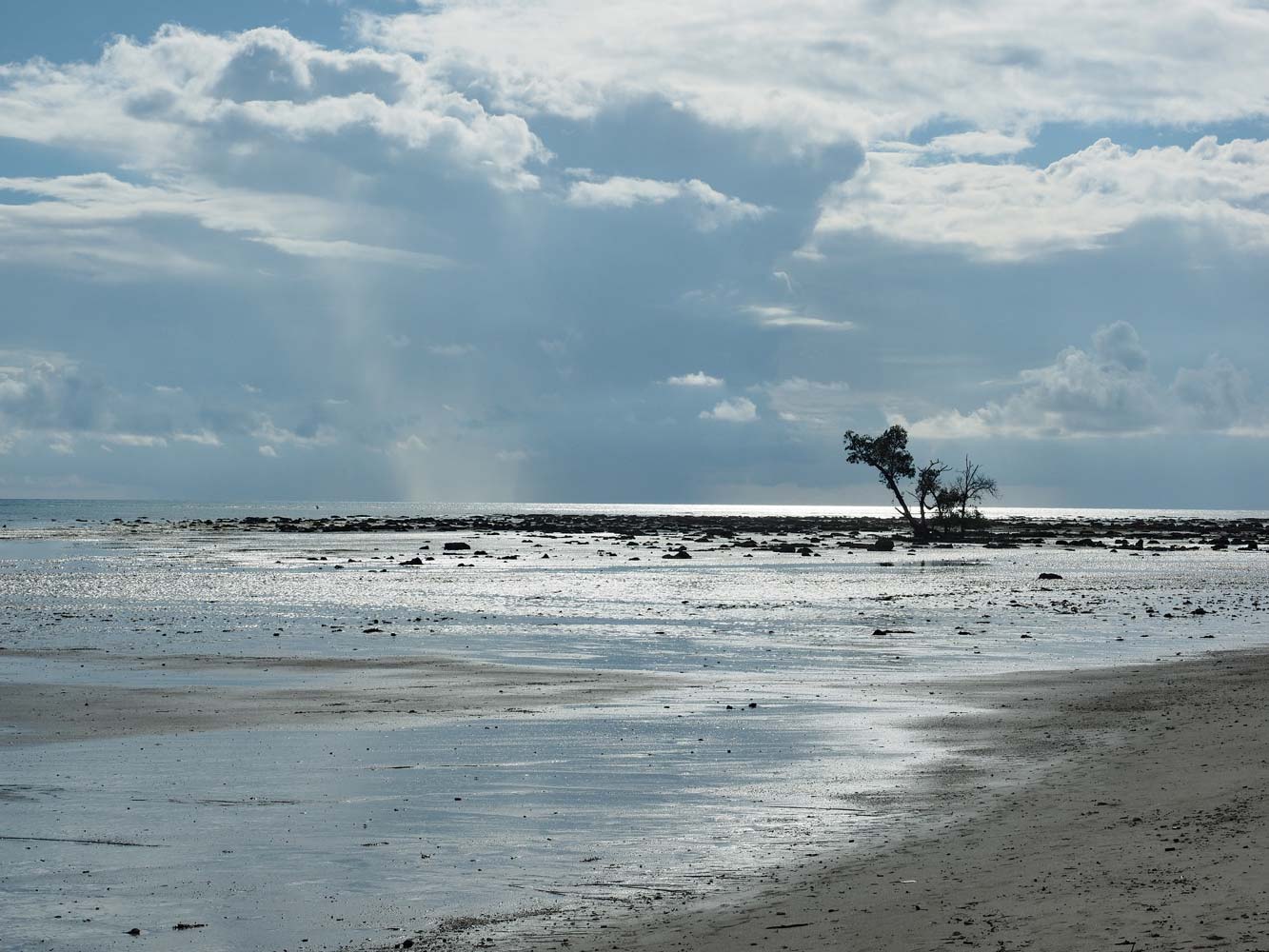
A passing storm
stays well out to sea.
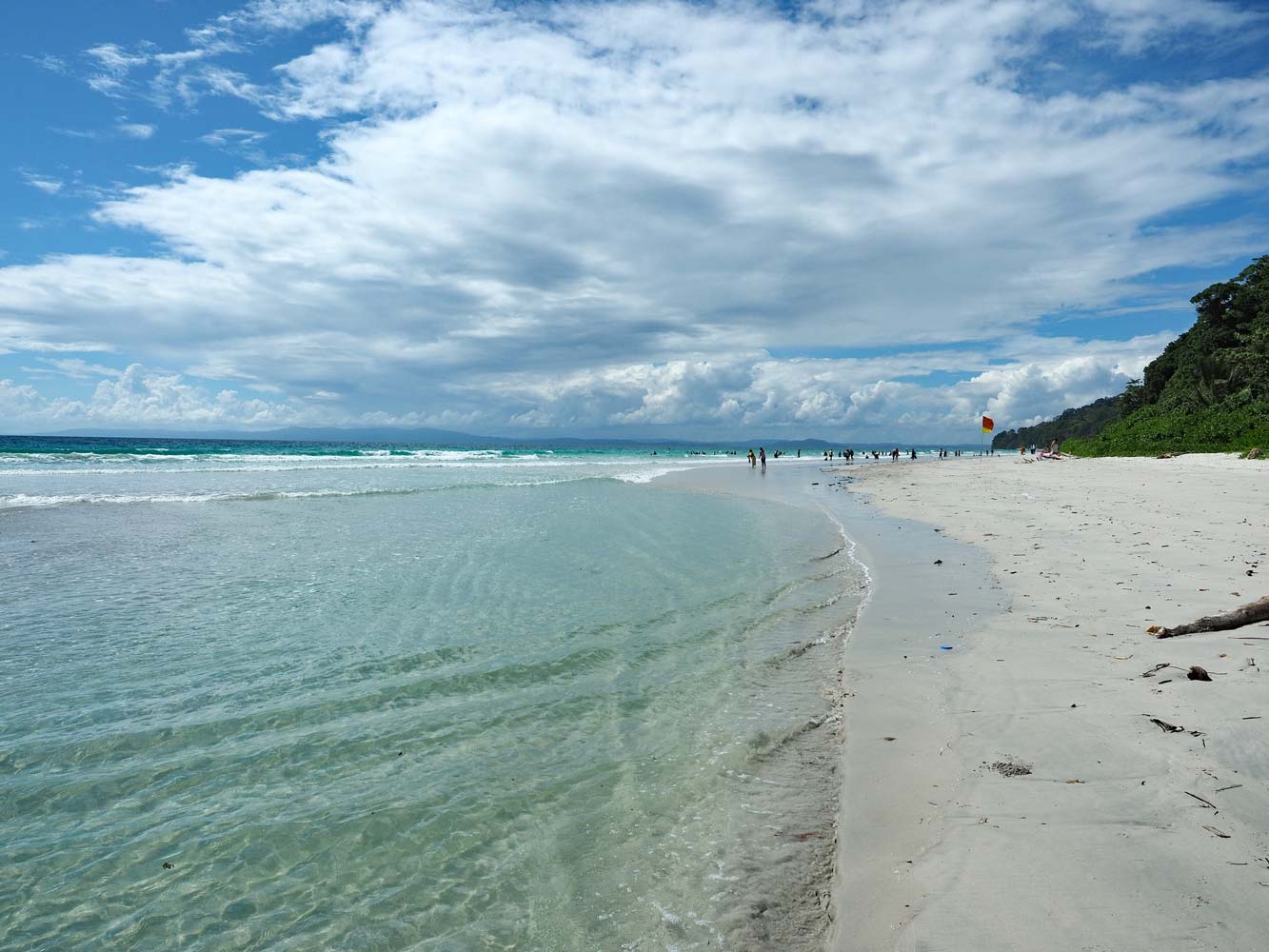
A grand day to be
outdoors!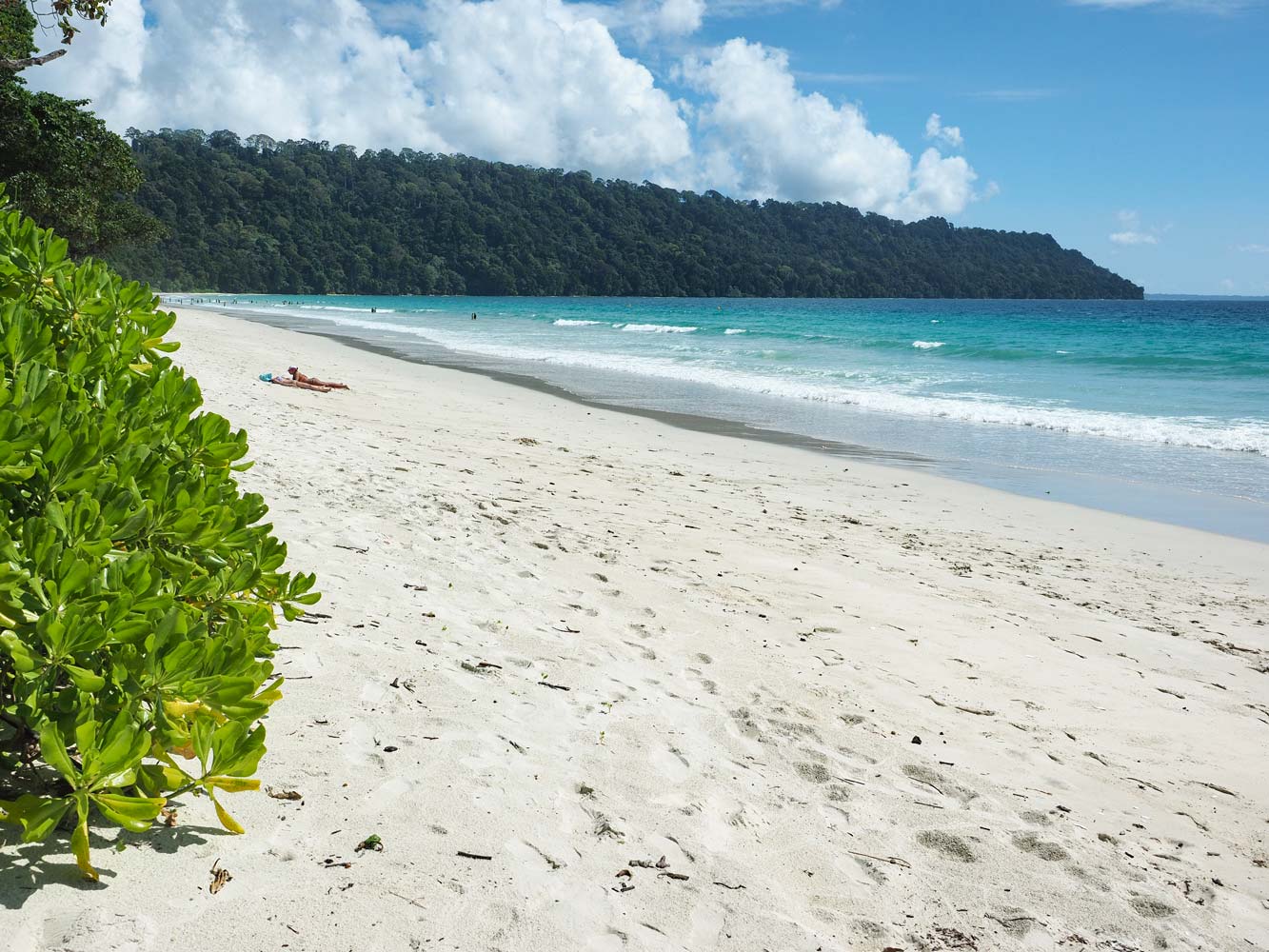
Dense jungle takes over from the south end of Radhanagar Beach.
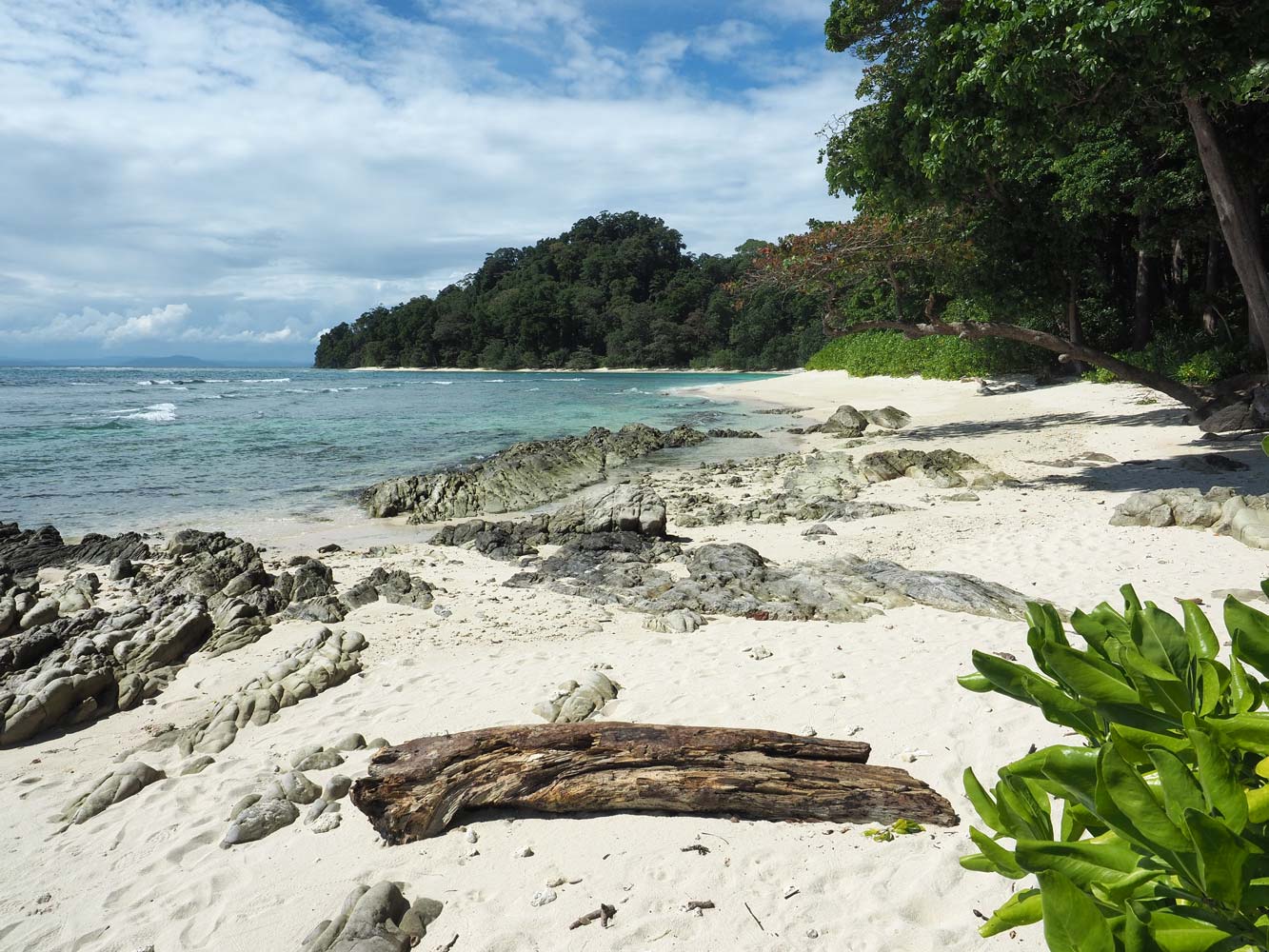
The little cove
beyond the rocks at the north end of Radhanagar Beach
I cycled back over the hills to Govind Nagar on the island’s eastern side, then rode south past Beach #5, where my hotel is, and continued another 5.5 kilometers to Kalapathar Beach at the end of the coastal road. The last part had very pleasant scenery with the surf gently crashing on my left and jungle-clad hills on the right. A couple passenger boats cruised by off shore, no doubt on the short hop between Havelock and the smaller, less developed Neil Island. Beyond lay the open Andaman Sea. After drinking a large green coconut and dining on strips of the soft meat, I rolled back to Beach #5 and returned the bicycle to its shop. Now I’ve cycled all of the island’s two main roads!
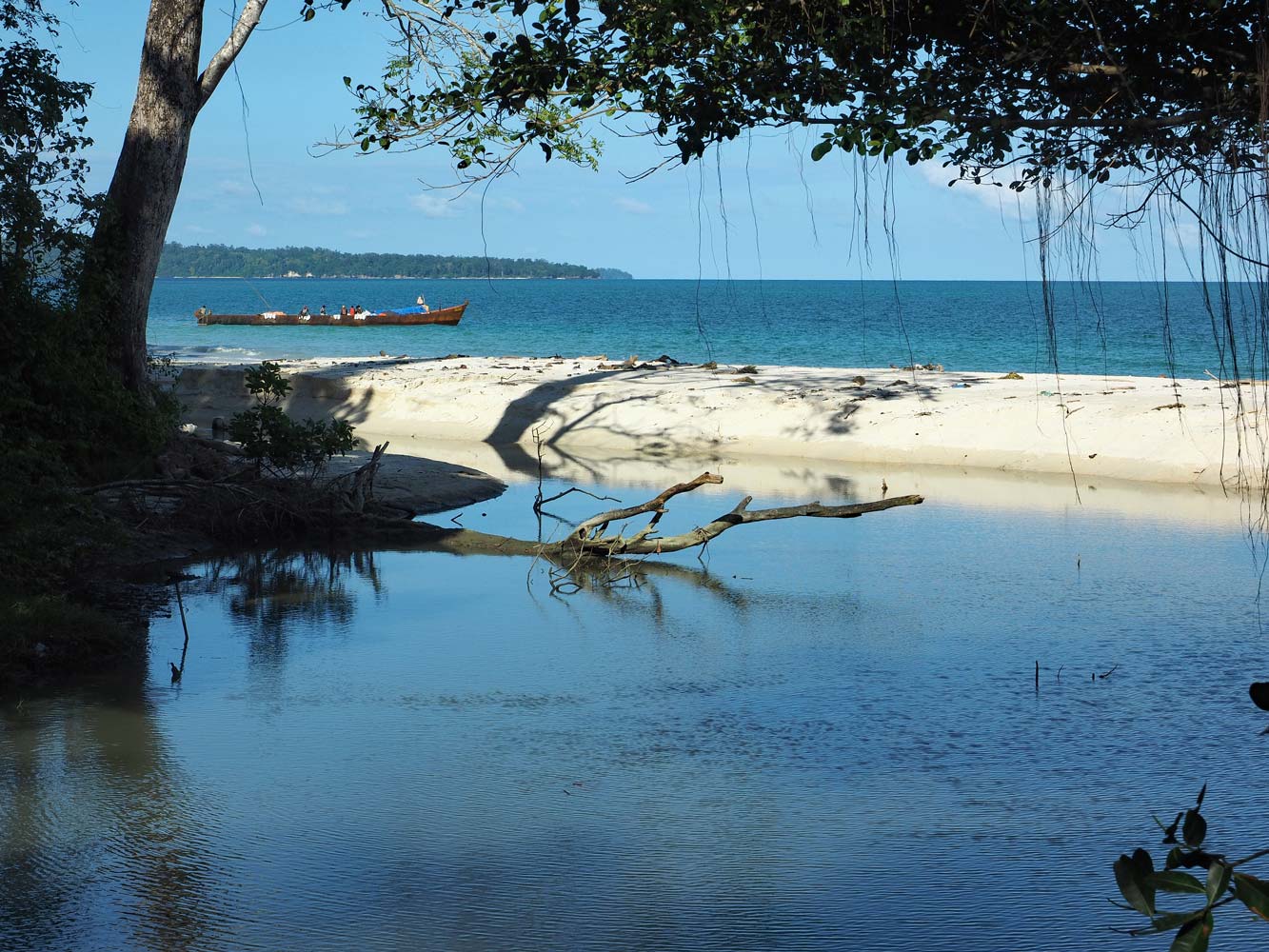
A work boat off the
east coast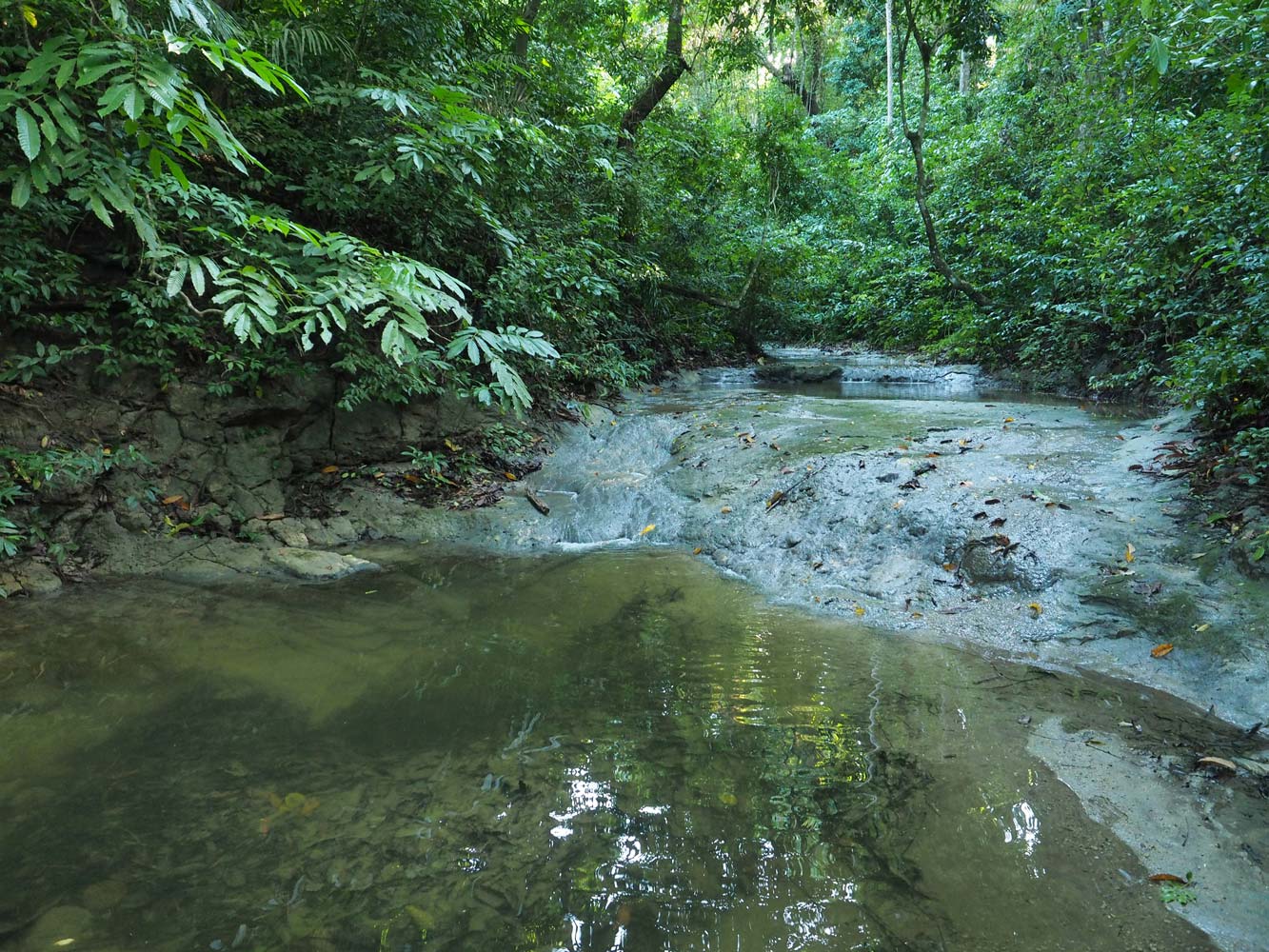
A
stream emerges from the jungle on the east coast.
With the fine weather, Andaman Bubbles http://andamanbubbles.com/
had run a scuba trip today, so I signed up for tomorrow’s pair of dives at a cost
of 5500 rupees. Havelock Island has about half a dozen companies that lead dives,
and I wasn’t aware if one company is better than the others. This one happens to
be just a few minutes’ walk from my resort, which will be appreciated tomorrow morning
when I head over for the 7 a.m. meet-up and breakfast. Dinners at Anju
Coco Resto have begun to be a habit as the food is so good! Tonight I went with
a palak paneer, then a dessert of a pair of hot gulab jamun balls with a little
ball of ice cream.
10 Dec. Beach 5, Havelock Island
On a pleasant
mostly sunny day I got a free breakfast of pancakes and tea at Fat Martin’s Café,
then our little group met up farther south at Andaman Bubbles gear shed to get suited
up. Equipment was similar to what I had experienced in Thailand, including a thin
‘shorty’ wet suit. No dock here, so we waded out, then transferred to a small boat
with outboard motor out to the dive boat, a larger wooden craft. The diesel engine
fired up and we motored for about an hour out to Dixon’s Pinnacles, southeast of
Havelock Island. The green hue of the shallow water gave way to deep blue sea. There
were just four customers: a couple doing a course with a dive master, then an Israeli
fellow and myself with our own divemaster, a local from the Andaman Islands named
‘Belgian.’ Three pinnacles lie submerged at a depth of about 18 meters, so the captain
had to navigate until the white float of the buoy line came into view and we tied
up. We made two dives, each to a depth of 27 meters and lasting for 37 minutes,
with a surface interval of one hour and 15 minutes. Visibility turned out to be
less than normal at about 5 meters, but we saw a great many fish. Snappers of a
golden hue swam in dense schools while larger fish such as Napoleon wrasse, trevally,
and groupers tended to be solitary. Anemones grow atop the pinnacles and some harbored
little orange-and-white anemone fish. A blue-spotted stingray lay partially covered
by sand on the bottom, but took off at a fast pace when my buddy moved in for a
shot with his Go-Pro camera. Hard corals are sparse, but we saw many soft
corals and large sponges. On the way up we saw a medium-sized jellyfish pulsating.
The second dive had similar abundant fish. There seemed to be a lot more larger-sized
fish here than in dive sites I’ve been to in Thailand and certainly in Vietnam where
a great many fishermen roam. The sea had gentle waves and I got through
the day without seasickness, which helps a lot for enjoyment on the water! Also
nobody on the boat smoked, which was nice. Now I have logged 130 dives since getting
recertified on Koh Tao in Thailand in 2006. I have more dives than that since my
first certification 47 years ago in Key Largo, Florida. In the evening I celebrated
with a North Indian thali at Anju Coco Resto.
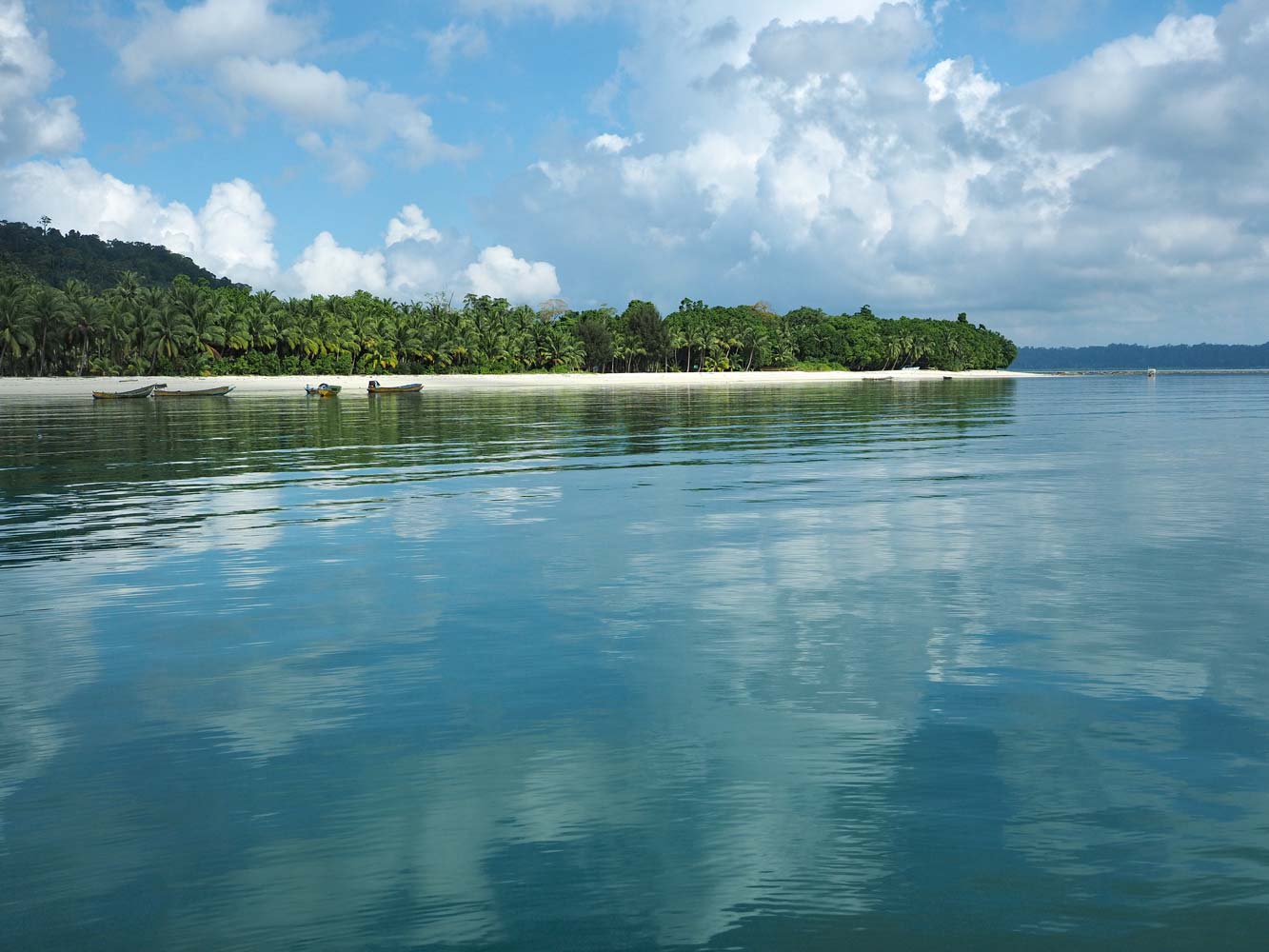
A glassy sea in the
morning near Beach 5
11 Dec. Beach 5, Havelock
Island
On a hot and mostly sunny day I started with a good breakfast at Anju
Coco Resto—tomato omelet, hash-brown pancake, butter toast, and milk tea. Then I
rented a bicycle and rode north to the main village Govind Nagar where I got photocopies
of my passport pages and permit, then continued to the ATMs, but none worked. I
went into the Bank of India office to see if foreign currency could be exchanged,
but no luck with that either. Bad luck followed me at the government ferry office
near the pier where I waited and waited and waited to buy a ticket for the boat
to Long Island or nearby Rangat in two days time. Although there was a senior citizen
line, the women’s line wouldn’t let us in. The ticket agents seemed to take forever
with every ticket, and I gave up waiting. Back at my resort, the manager offered
for one of his staff to buy the ticket for a fee of 300 rupees, which seemed reasonable,
but he later told me that I would have to go myself tomorrow for the ticket. I barely
have enough cash for my hotel bill, so I will try the ATMs tomorrow. During the
afternoon I worked on sorting photos of the recent European trip. Then off to Anju
Coco Resto at dinner time for South Indian fare. A Christian group singing songs
accompanied by two kids in Santa Claus masks and costumes made the rounds of the
village and came into the restaurant. I didn’t recognize the songs, but assumed
they were Christmas tunes.
12 Dec. Beach 5, Havelock Island
On another
nice and mostly sunny day—that sun sure is hot, though—I headed north on foot and
rickshaw with a breakfast stop at Anju Coco Resto. Bad luck again with the ATMs
as none are working today, though a guard at the Axis bank promised a functioning
ATM tomorrow. We’ll see. More bad luck at the ferry office where all tickets for
the Long Island/Rangat ferry tomorrow had sold out. I was still determined to leave
Havelock Island, so easily bought a ticket with the private company Makruzz back
to Port Blair; the cheapest fare is listed as 1150 rupees, but add taxes and fees
and it comes to 1407 rupees. I phoned the Aashiaanaa Residency Inn in Port Blair
to request a room for tomorrow.
From Port Blair I plan to get a bus
ticket to Rangat and a short ferry to Long Island. I would like to experience traveling
the length of the Andamans by road even though it’s a much longer journey than by
sea. I hung out in my room the rest of the day with reading, writing, and photo
projects. Luckily I had enough rupees to pay the hotel room and food bills with
a little to spare. In the evening I walked over to Anju Coco Resto for another fine
dinner, this time a creamy malai kofta.
13 Dec. Port Blair
On a
fine mostly sunny tropical day, I had breakfast at the resort, then hung around
a bit before getting an autorickshaw to the pier. While waiting for the Makruzz
check-in to open I wandered over to see the wooden cargo boats. A large one named
‘Jesus’ lay docked at a pier and the others had simply pulled up on the beach. No
fancy port equipment here as goods are loaded and unloaded by hand, piece by piece.
Passenger boats went to and fro from the main pier. A helicopter cruised overhead,
no doubt on its way to Port Blair; tourists sometimes get on these flights, but
baggage is said to be limited to 5 kilograms. After waiting in a long line I got
checked in, waited in another long line to enter the pier area, and waited again
for baggage to be stored on a lower deck. Finally onboard I got an airline-style
seat on the main deck, nicely air-conditioned and with windows on all sides. The
exceptionally smooth journey in this Singapore-built catamaran took a bit less than
2.5 hours.
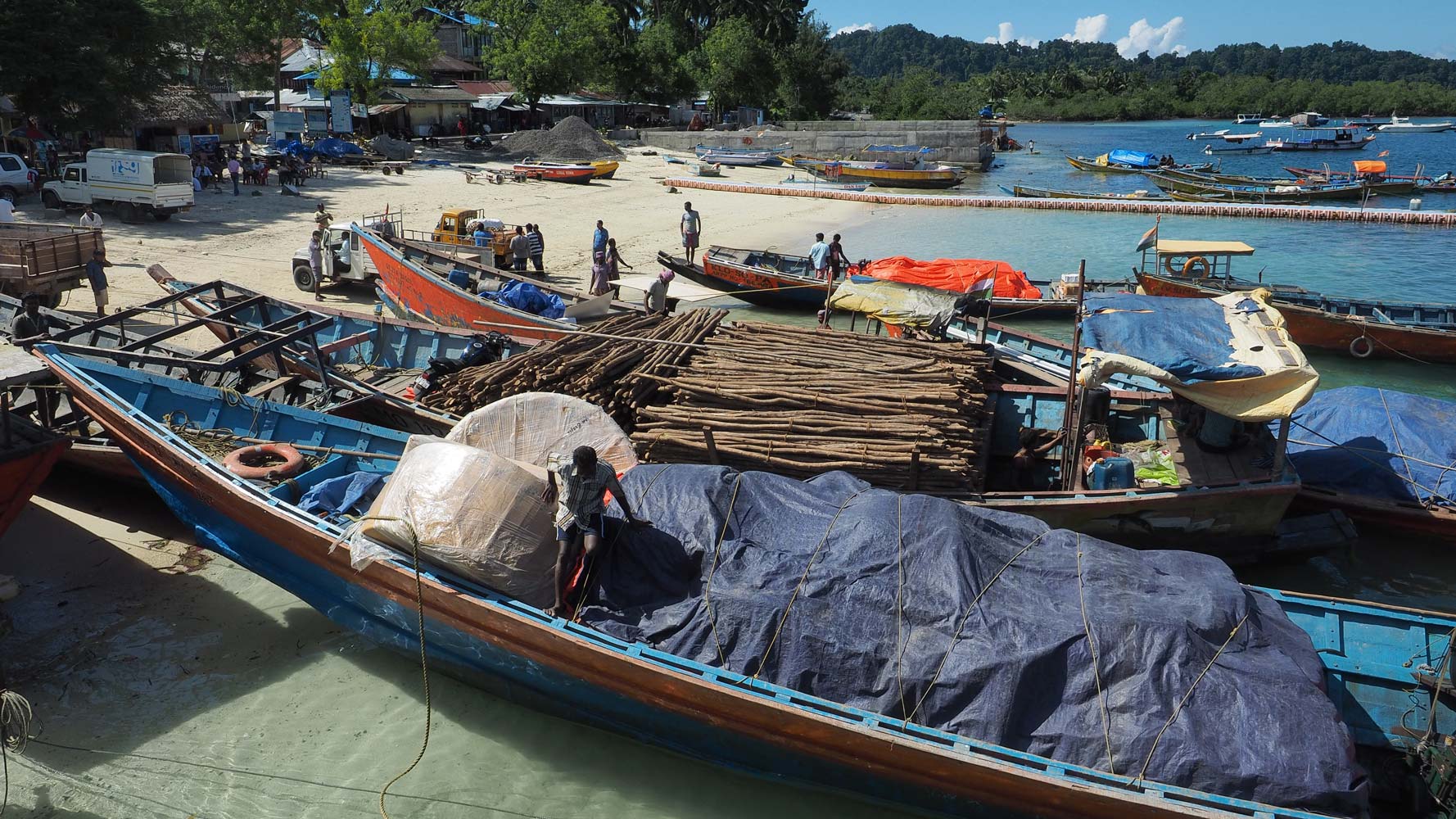
The busy beach near
the pier at the north end of Havelock Island
On arrival at Port Blair I walked to the Aashiaanaa Residency
Inn and got a small fan room with a handy little table for 900 rupees. I could stay
only one night, however, as all rooms were booked for tomorrow night, so that meant
I had to get a bus ticket. The bus station was less than a kilometer away to the
southeast, so I strolled over and got the last seat for tomorrow’s 6:45 a.m. bus
to Rangat at a cost of 160 rupees. The ticket seller said the trip would take maybe
7 hours, and a fellow ticket-buyer mentioned that the highway isn’t so good. If
I was lucky with timing, I might be able to catch the last ferry from a nearby pier
over to Long Island.
A little farther up the road near a gold-colored
statue of Mahatma Gandhi, I went to the State Bank of India and milked an ATM three
times for a total of 30,000 rupees, a little under $500. I turned northeast into
Aberdeen Bazaar, densely packed with shops and a covered market, where I picked
up a few supplies at a supermarket. Many shops sold Christmas decorations including
little Santa Clauses, artificial trees, and large illuminated paper stars with cut
patterns. At the clocktower I turned uphill to Annapurna Cafeteria, a “pure-vegetarian”
place, and went with South Indian cuisine—a tomato uttappam and a mixed-vegetable
masala dosa. Back at the hotel I got online with the creaky wi-fi and managed to dive
into e-mails, the news, and check finances. Then I reserved a room for the last
four nights (24-27 Dec.) of my time in the Andamans.